Resist composition and method for producing resist pattern
Sugihara , et al. July 30, 2
U.S. patent number 10,365,560 [Application Number 15/085,530] was granted by the patent office on 2019-07-30 for resist composition and method for producing resist pattern. This patent grant is currently assigned to SUMITOMO CHEMICAL COMPANY, LIMITED. The grantee listed for this patent is SUMITOMO CHEMICAL COMPANY, LIMITED. Invention is credited to Junji Nakanishi, Takashi Nishimura, Masako Sugihara.
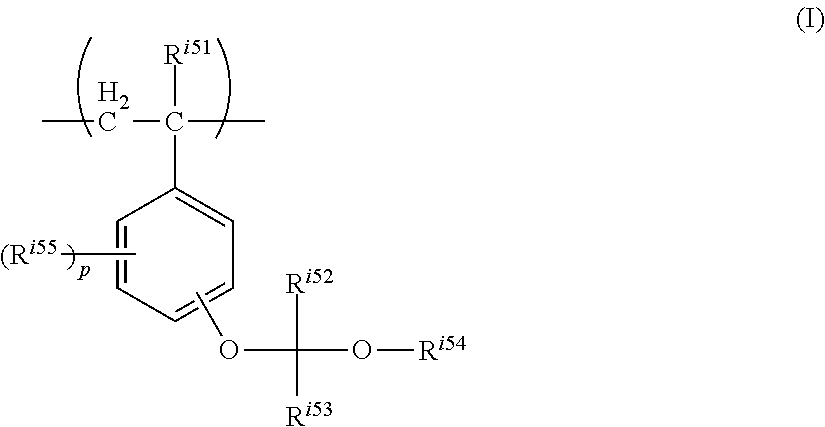
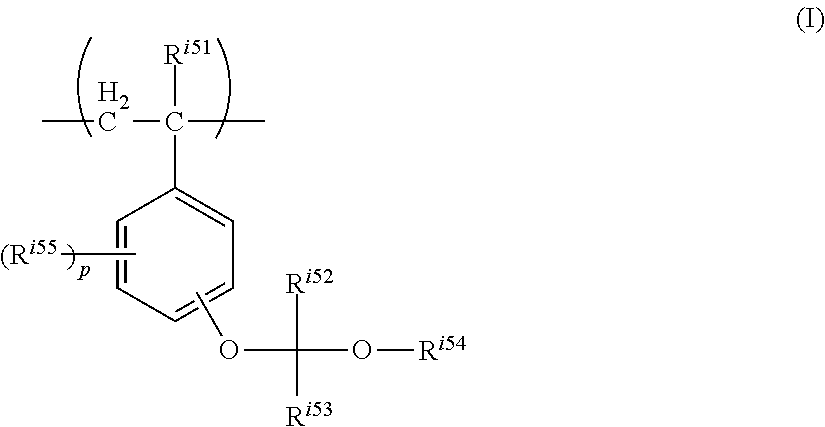


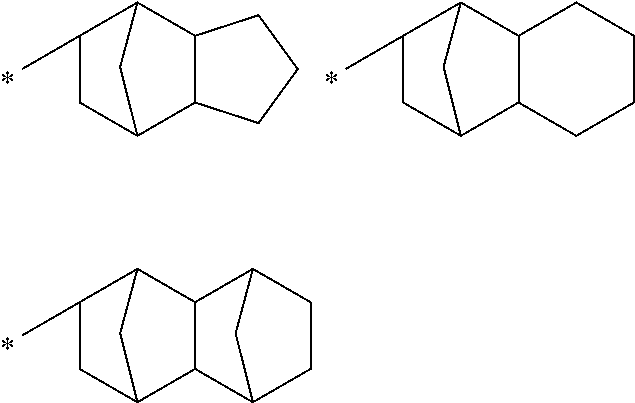




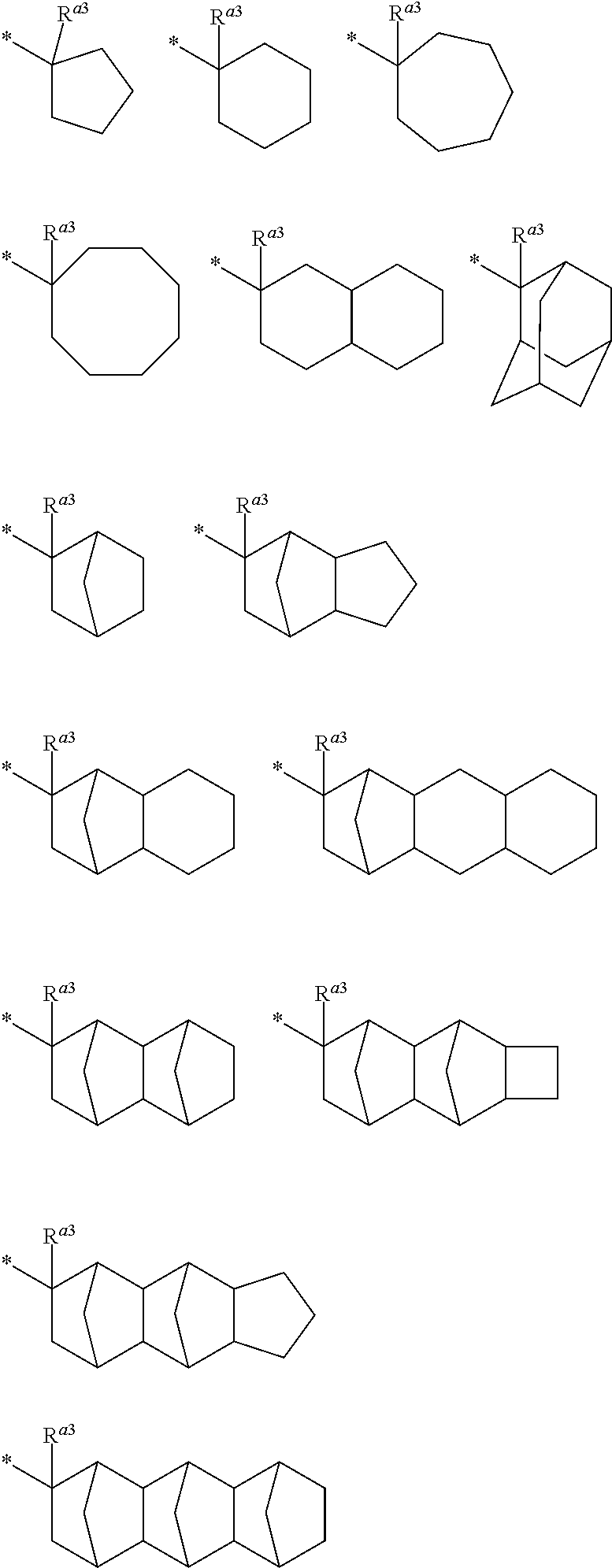
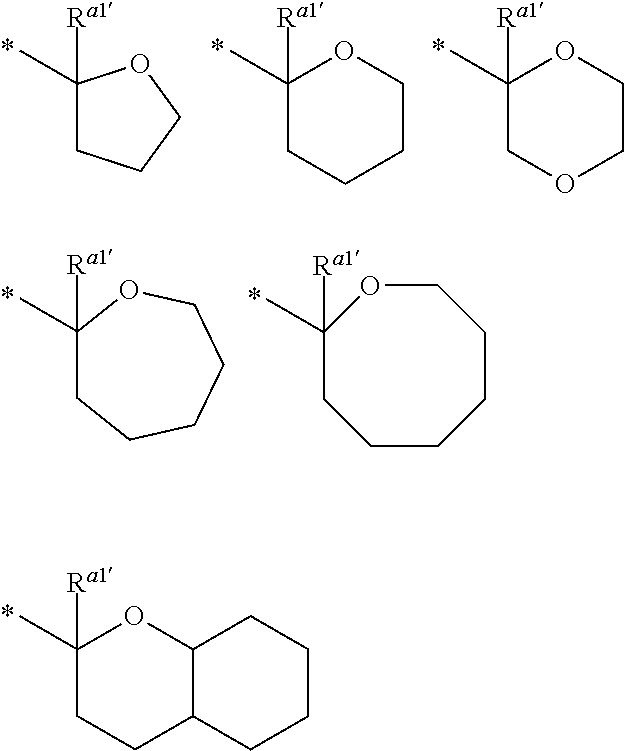

View All Diagrams
| United States Patent | 10,365,560 |
| Sugihara , et al. | July 30, 2019 |
Resist composition and method for producing resist pattern
Abstract
A resist composition contains: a resin having a structural unit represented by formula (I), an alkali-soluble resin, an acid generator, and a solvent: ##STR00001## wherein R.sup.i51 represents a hydrogen atom or a methyl group, R.sup.i52 and R.sup.i53 each independently represent a hydrogen atom or a C.sub.1 to C.sub.12 hydrocarbon group, R.sup.i54 represents a C.sub.5 to C.sub.20 alicyclic hydrocarbon group, R.sup.i55 represents a C.sub.1 to C.sub.6 alkyl group or a C.sub.1 to C.sub.6 alkoxy group, and "p" represents an integer of 0 to 4.
| Inventors: | Sugihara; Masako (Osaka, JP), Nakanishi; Junji (Osaka, JP), Nishimura; Takashi (Osaka, JP) | ||||||||||
|---|---|---|---|---|---|---|---|---|---|---|---|
| Applicant: |
|
||||||||||
| Assignee: | SUMITOMO CHEMICAL COMPANY,
LIMITED (Tokyo, JP) |
||||||||||
| Family ID: | 57016080 | ||||||||||
| Appl. No.: | 15/085,530 | ||||||||||
| Filed: | March 30, 2016 |
Prior Publication Data
| Document Identifier | Publication Date | |
|---|---|---|
| US 20160291465 A1 | Oct 6, 2016 | |
Foreign Application Priority Data
| Mar 31, 2015 [JP] | 2015-073001 | |||
| Current U.S. Class: | 1/1 |
| Current CPC Class: | G03F 7/322 (20130101); G03F 7/0397 (20130101); G03F 7/40 (20130101); G03F 7/38 (20130101); G03F 7/0045 (20130101); G03F 7/0392 (20130101); G03F 7/085 (20130101) |
| Current International Class: | G03F 7/039 (20060101); G03F 7/004 (20060101); G03F 7/085 (20060101); G03F 7/32 (20060101); G03F 7/38 (20060101); G03F 7/40 (20060101) |
References Cited [Referenced By]
U.S. Patent Documents
| 3779778 | December 1973 | Smith et al. |
| 3849137 | November 1974 | Barzynski et al. |
| 4576902 | March 1986 | Saenger et al. |
| 4822716 | April 1989 | Onishi et al. |
| 4857437 | August 1989 | Banks et al. |
| 5017453 | May 1991 | Onishi et al. |
| 5073476 | December 1991 | Meier et al. |
| 5198520 | March 1993 | Onishi et al. |
| 5260410 | November 1993 | Schwalm |
| 5453341 | September 1995 | Schwalm |
| 5891603 | April 1999 | Kodama |
| 2005/0079441 | April 2005 | Takahashi |
| 2007/0246441 | October 2007 | Kim |
| 2010/0151380 | June 2010 | Ando et al. |
| 2011/0254133 | October 2011 | Pohlers |
| 2013/0189533 | July 2013 | Okuyama |
| 2013/0330669 | December 2013 | Kawamura |
| 2014/0017611 | January 2014 | Sugihara |
| 2015/0086927 | March 2015 | Sugihara |
| 39 14407 | Oct 1990 | DE | |||
| 0 126 712 | Nov 1984 | EP | |||
| 55-164824 | Dec 1980 | JP | |||
| 62-69263 | Mar 1987 | JP | |||
| 62-153853 | Jul 1987 | JP | |||
| 63-26653 | Feb 1988 | JP | |||
| 63-146029 | Jun 1988 | JP | |||
| 63-146038 | Jun 1988 | JP | |||
| 63-163452 | Jul 1988 | JP | |||
| 2000-241980 | Sep 2000 | JP | |||
| 2001-75277 | Mar 2001 | JP | |||
| 2004-198944 | Jul 2004 | JP | |||
| 2004-347951 | Dec 2004 | JP | |||
| 2010-79081 | Apr 2010 | JP | |||
| 2010-204634 | Sep 2010 | JP | |||
| 2011-75864 | Apr 2011 | JP | |||
| WO 2014/104195 | Jul 2014 | WO | |||
Other References
|
Derwent English abstract for WO 2014/104195 A1 (2014). cited by examiner . Derwent English abstract for JP 2004-347951 (2004). cited by examiner . JPO English abstract for JP 2004-198944 (2004). cited by examiner. |
Primary Examiner: Lee; Sin J
Attorney, Agent or Firm: Birch, Stewart, Kolasch & Birch, LLP
Claims
What is claimed is:
1. A resist composition comprising: a resin having a structural unit represented by formula (I), an alkali-soluble resin, a resin (A3) including an alkaline-insoluble resin consisting of a structural unit having no acid-labile group, an acid generator, a solvent, an adhesion improver selected from the group consisting of a sulfur-containing compound, an aromatic hydroxyl compound, a benzotriazol compound, and a triazine compound; and at least one quencher represented by the formula (C1) or the formula (C2); ##STR00082## wherein R.sup.i51 represents a hydrogen atom or a methyl group, R.sup.i52 and R.sup.i53 each independently represent a hydrogen atom or a C.sub.1 to C.sub.12 hydrocarbon group, R.sup.i54 represents a C.sub.5 to C.sub.20 alicyclic hydrocarbon group, R.sup.i55 in each occurrence independently represents a C.sub.1 to C.sub.6 alkyl group or a C.sub.1 to C.sub.6 alkoxy group, and "p" represents an integer of 0 to 4; ##STR00083## wherein R.sup.c1, R.sup.c2 and R.sup.c3 each independently represent a hydrogen atom, a C.sub.1 to C.sub.6 alkyl group, a C.sub.5 to C.sub.10 alicyclic hydrocarbon group or a C.sub.6 to C.sub.10 aromatic hydrocarbon group, and a hydrogen atom contained in the alkyl group and the alicyclic hydrocarbon group may be replaced by a hydroxy group, an amino group or a C.sub.1 to C.sub.6 alkoxy group, and a hydrogen atom contained in the aromatic hydrocarbon group may be replaced by a C.sub.1 to C.sub.6 alkyl group, a C.sub.1 to C.sub.6 alkoxy group or a C.sub.5 to C.sub.10 alicyclic hydrocarbon group; ##STR00084## wherein the ring W.sup.1 represents a nitrogen-containing heterocyclic ring, or a benzene ring having a substituted or unsubstituted amino group, and a hydrogen atom contained in the heterocyclic ring and benzene ring may be replaced by a hydroxy group or a C.sub.1 to C.sub.4 alkyl group; A.sup.1 represents a phenyl group or a naphthyl group, and nc represents an integer of 2 or 3; and wherein the resist composition does not comprise a silicon-containing adhesion improver.
2. The resist composition according to claim 1 wherein the alkali-soluble resin is a novolak resin.
3. The resist composition according to claim 1 wherein the acid generator is a compound having a group represented by formula (B1): ##STR00085## wherein R.sup.b1 represents a C.sub.1 to C.sub.18 hydrocarbon group in which a hydrogen atom may be replaced by a fluorine atom and in which a methylene group may be replaced by an oxygen atom or a carbonyl group.
4. A method for producing a resist pattern comprising steps (1) to (4); (1) applying the resist composition according to claim 1 onto a substrate; (2) drying the applied composition to form a composition layer; (3) exposing the composition layer; and (4) developing the exposed composition layer.
5. The resist composition according to claim 1 wherein the quencher is a quencher represented by the formula (C2).
Description
CROSS-REFERENCE TO RELATED APPLICATIONS
This application claims priority to Japanese Application No. 2015-73001 filed on Mar. 31, 2015. The entire disclosure of Japanese Application No. 2015-73001 is incorporated hereinto by reference.
BACKGROUND
1. Field of the Invention
The disclosure relates to a resist composition and a method for producing resist pattern.
2. Related Art
In the mounting of the semiconductor chip being thin film and having multi-pin, the protruding electrodes of about 4 to 15 0 .mu.m height, which is connection terminals (bumps), are formed on the substrate (wafer) by photolithography. As a method for forming such a connection terminal, JP2011-75864A1 mentions the use of a resist composition containing a resin having a structural unit derived from p-hydroxystyrene.
SUMMARY
The present application provides the inventions as follow.
[1] A resist composition contains:
a resin having a structural unit represented by formula (I),
an alkali-soluble resin,
an acid generator, and
a solvent:
##STR00002##
wherein R.sup.i51 represents a hydrogen atom or a methyl group,
R.sup.i52 and R.sup.i53 each independently represent a hydrogen atom or a C.sub.1 to C.sub.12 hydrocarbon group,
R.sup.i54 represents a C.sub.5 to C.sub.20 alicyclic hydrocarbon group,
R.sup.i55 in each occurrence independently represents a C.sub.1 to C.sub.6 alkyl group or a C.sub.1 to C.sub.6 alkoxy group, and
"p" represents an integer of 0 to 4.
[2] The resist composition according to [1] wherein the alkali-soluble resin is a novolak resin.
[3] The resist composition according to [1] or [2] wherein the acid generator is a compound having a group represented by formula (B1):
##STR00003##
wherein R.sup.b1 represents a C.sub.1 to C.sub.18 hydrocarbon group in which a hydrogen atom may be replaced by a fluorine atom and in which a methylene group may be replaced by an oxygen atom or a carbonyl group.
[4] The resist composition according to any one of [1] to [3] further contains an adhesion improver.
[5] A method for producing a resist pattern includes steps (1) to (4);
(1) applying the resist composition according to any one of [1] to [4] onto a substrate;
(2) drying the applied composition to form a composition layer;
(3) exposing the composition layer; and
(4) developing the exposed composition layer.
BRIEF DESCRIPTION OF DRAWINGS
FIG. 1(a) illustrates an excellent cross-sectional view of a photoresist pattern which has substantially rectangle shape at its top and bottom portions, and
FIG. 1(b) illustrates a cross-sectional view of a photoresist pattern which has a round shape at its bottom portion.
DETAILED DESCRIPTION OF DISCLOSURE
In the specification, the term "(meth)acrylic monomer" means a monomer having a structure of "CH.sub.2.dbd.CH--CO--" or "CH.sub.2.dbd.C(CH.sub.3)--CO--", as well as "(meth)acrylate" and "(meth)acrylic acid" mean "an acrylate or methacrylate" and "an acrylic acid or methacrylic acid," respectively. The group described herein, which can take both the linear structure and branch structure, may be either. When stereo isomers exist, it includes all stereoisomers. The indefinite articles "a" and "an" are taken as the same meaning as "one or more".
The term "solid components" means components other than solvents in a resist composition.
<Resist Composition>
The resist composition according to the disclosure contains
a resin having a structural unit represented by formula (I) (which is sometimes referred to as "resin (A1)"),
an alkali-soluble resin (which is sometimes referred to as "resin (A2)"),
an acid generator (which is sometimes referred to as "acid generator (B)"), and
a solvent (which is sometimes referred to as "solvent (D)").
The resist composition of the disclosure may further contain a resin that is different from the resin (A1) and the resin (A2) (which is sometimes referred to as "resin (A3)"), a quencher (which is sometimes referred to as "quencher (C)") and an adhesion improver (which is sometimes referred to as "adhesion improver (E)").
<Resin (A1)>
The resin (A1) has the structural unit represented by formula (I) (which is sometimes referred to as "structural unit (I)"). In addition to the structural unit (I), the resin (A1) may further has a structural unit having an acid-labile group (which is sometimes referred to as "structural unit (a1)"), a structural unit having no acid-labile group (which is sometimes referred to as "structural unit (a2)") and another type of known structural unit in the art.
##STR00004##
In the formula, R.sup.i51 represents a hydrogen atom or a methyl group,
R.sup.i52 and R.sup.i53 each independently represent a hydrogen atom or a C.sub.1 to C.sub.12 hydrocarbon group,
R.sup.i54 represents a C.sub.5 to C.sub.20 alicyclic hydrocarbon group,
R.sup.i55 in each occurrence independently represents a C.sub.1 to C.sub.6 alkyl group or a C.sub.1 to C.sub.6 alkoxy group, and
"p" represents an integer of 0 to 4.
The hydrocarbon group for R.sup.i52 and R.sup.i53 may be an alkyl group, an alicyclic hydrocarbon group, an aromatic hydrocarbon group and a combination thereof.
Examples of the alkyl group include methyl, ethyl, propyl, n-butyl, n-pentyl, n-hexyl, n-heptyl and n-octyl groups.
The alicyclic hydrocarbon group may be monocyclic or polycyclic group. Examples of the monocyclic alicyclic hydrocarbon group include a cycloalkyl group such as cyclopentyl, cyclohexyl, cycloheptyl and cyclooctyl groups. Examples of the polycyclic alicyclic hydrocarbon group include decahydronaphthyl, adamantyl, norbornyl, and the following groups;
##STR00005##
wherein * represents a binding position.
The alicyclic hydrocarbon group is preferably a C.sub.3 to C.sub.12 alicyclic hydrocarbon group.
Examples of groups combining the alkyl group and the alicyclic hydrocarbon group include methylcyclohexyl, dimethylcyclohexyl, methylnorbornyl, cyclohexylmethyl, adamantylmethyl and norbornylethyl groups.
Examples of the aromatic hydrocarbon group include an aryl group such as phenyl, naphthyl, anthryl, biphenyl and phenanthryl group.
Examples of groups combining the alkyl group and the aromatic hydrocarbon group include p-methylphenyl, p-tert-butylphenyl, p-adamantylphenyl, tolyl, xylyl, cumenyl, mesityl, 2,6-diethyl phenyl and 2-methyl-6-ethylphenyl groups.
Examples of groups combining the aromatic hydrocarbon group and the alkyl group and/or alicyclic hydrocarbon group include an aralkyl group such as benzyl, phenethyl, phenylpropyl, naphthylmethyl and naphthylethyl groups, as well as phenylcyclohexyl and naphthylcyclohexyl groups.
Examples of the alicyclic hydrocarbon group for R.sup.i54 and the alkyl group for R.sup.i55 are the same examples as the group described above.
Examples of the alkoxy group for R.sup.i55 includes methoxy, ethoxy, propoxy, butoxy, pentyloxy, hexyloxy, heptyloxy, octyloxy, decyloxy and dodecyloxy groups.
Among them, R.sup.i52 and R.sup.i53 are preferably a hydrogen atom or an alkyl group, and more preferably one of R.sup.i52 and R.sup.i53 is a halogen atom and the other of R.sup.i52 and R.sup.i53 is an alkyl group.
R.sup.i54 is preferably a C.sub.5 to C.sub.16 alicyclic hydrocarbon group, more preferably cyclopentyl, cyclohexyl, adamantyl and norbornyl groups.
"p" is preferably 0 or 1, and more preferably 0.
Examples of the structural unit (I) include structural units derived from monomers represented by following ones.
##STR00006## ##STR00007##
Among them, the structural units derived from monomers represented by formulae (I-2), (I-3), (I-4), (I-5) and (I-8) are preferred, and the structural units derived from monomers represented by formulae (I-3), (I-4) and (I-5) are more preferred.
The content of the structural unit (I) in the resin (A1) is preferably 5 to 80% by mole, more preferably 10 to 70% by mole, still more preferably 15 to 60% by mole, and particularly preferably 20 to 50% by mole with respect to the total structural units contained in the resin (A1).
The structural unit (I) has an acid-labile group, which is different from the structural unit (a1) not represented by formula (I). The structural unit (I) shows increased solubility in an alkaline aqueous solution when an acid labile-group has been removed therefrom by the action of an acid. The resin (A1) shows increased solubility in an alkaline aqueous solution by action of an acid.
The "increased solubility in an alkaline aqueous solution by the action of an acid", means to increase the solubility in an alkaline aqueous solution by contact with an acid. The resin is preferably a resin which is insoluble or poorly soluble in an alkali aqueous solution before contact with the acid, and becomes soluble in an alkaline aqueous solution after contact with the acid.
<Structural Unit (a1)>
In the structural unit (a1), the "acid-labile group" means a group having a leaving group which is detached by contacting with an acid resulting in forming a hydrophilic group such as a hydroxy or carboxy group. Examples of the acid-labile group include a group represented by the formula (1) and the formula (2).
##STR00008##
In the formula (1), R.sup.a1, R.sup.a2 and R.sup.a3 each independently represent a C.sub.1 to C.sub.8 alkyl group, a C.sub.3 to C.sub.20 alicyclic hydrocarbon group, or R.sup.a1 and R.sup.a2 may be bonded together with a carbon atom bonded thereto to form a C.sub.2 to C.sub.20 divalent hydrocarbon group and R.sup.a1 represents a C.sub.1 to C.sub.8 alkyl group or a C.sub.3 to C.sub.20 alicyclic hydrocarbon group, and * represents a binding position.
##STR00009##
In the formula (2), R.sup.a1' and R.sup.a2' each independently represent a hydrogen atom or a C.sub.1 to C.sub.12 hydrocarbon group, R.sup.a1' represents a C.sub.1 to C.sub.20 hydrocarbon group, or R.sup.a1' represents a hydrogen atom or a C.sub.1 to C.sub.12 hydrocarbon group, and R.sup.a2' and R.sup.a3' are bonded together with a carbon atom and an oxygen atom bonded thereto to form a divalent heterocyclic group having 2 to 20 carbon atoms, and a methylene group contained in the hydrocarbon group or the divalent heterocyclic group may be replaced by an oxygen atom or a sulfur atom, and * represents a binding position.
Examples of the alkyl group and alicyclic hydrocarbon group for R.sup.a1 to R.sup.a3 are the same examples as the group described in R.sup.i52 and R.sup.i53.
When R.sup.a1 and R.sup.a2 is bonded together to form a divalent hydrocarbon group, examples of the group --C(R.sup.a1)(R.sup.a2)(R.sup.a3) include the following groups. The divalent hydrocarbon group is preferably a C.sub.3 to C.sub.12 alicyclic hydrocarbon group. In each of the formulae, * represent a binding position to --O--.
##STR00010##
Specific examples of the group represented by the formula (1) include, for example, an alkoxycarbonyl group (a group in which R.sup.a1 to R.sup.a3 are alkyl groups, preferably tert-butoxycarbonyl group, in the formula (1)),
1-alkylcyclopentane-1-yloxycarbonyl group and 1-alkylcyclohexane-1-yloxycarbonyl group (a group in which R.sup.a1 and R.sup.a2 form a cyclopentyl or a cyclohexyl group, and R.sup.a3 is an alkyl group, in the formula (1)), and
1-(cyclopentane-1-yl)-1-alkylalkoxycarbonyl group and 1-(cyclohexane-1-yl)-1-alkylalkoxycarbonyl group (a group in which R.sup.a1 and R.sup.a2 are an alkyl group, and R.sup.a3 a cyclopentyl or a cyclohexyl group, in the formula (1)).
The hydrocarbon group for R.sup.a1' to R.sup.a3' in formula (2) is the same examples as the group described in R.sup.i52 and R.sup.i53.
Examples of the divalent heterocyclic group formed by binding with R.sup.a2' and R.sup.a3' with a carbon atom and an oxygen atom bonded thereto include the following groups. * represent a binding position.
##STR00011##
In each formula, R.sup.a1' is preferably a hydrogen atom.
Specific examples of the group represented by the formula (2) include the following groups. In each of the formulae, * represent a binding position.
##STR00012##
The monomer which derives the structural unit (a1) is preferably a monomer which has an acid-labile group and an ethylene unsaturated bond, and is more preferably a monomer having a group represented by the formula (1) and/or (2) and a ethylene unsaturated bond, provided that the monomers is those other than the monomers which derives the structural unit (a1).
The resin (A1) may have one kind of the structural unit (a1-1) or two or more of them.
Examples of the structural units (a1) preferably include the structural units represented by formula (a1-1) and formula (a1-2), these are sometimes referred to as the "structural unit (a1-1)" and "structural unit (a1-2)".
##STR00013##
In the formulae, R.sup.a1, R.sup.a2, R.sup.a3, R.sup.a1' and R.sup.a2' are as defined above. R.sup.a33' represents a C.sub.1 to C.sub.20 aliphatic or aromatic hydrocarbon group or R.sup.a2' and R.sup.a33' are bonded together with a carbon atom and an oxygen atom bonded thereto to form a divalent heterocyclic group having 2 to 20 carbon atoms.
R.sup.a4 and R.sup.a5 each independently represent a hydrogen atom or a methyl group,
R.sup.a6 in each occurrence independently represents a C.sub.1 to C.sub.6 alkyl group or a C.sub.1 to C.sub.6 alkoxy group, and
"mx" represents an integer of 0 to 4.
In the formula (a1-1), R.sup.a4 is preferably a hydrogen atom.
In the formula (a1-2), R.sup.a1' is preferably a hydrogen atom.
R.sup.a2' is preferably a C.sub.1 to C.sub.12 hydrocarbon group, and more preferably a methyl group or an ethyl group.
Examples of R.sup.a33' preferably include a C.sub.1 to C.sub.18 alkyl group, a C.sub.6 to C.sub.18 aromatic hydrocarbon group or a combination thereof, and more preferably a C.sub.1 to C.sub.18 alkyl group or a C.sub.7 to C.sub.18 aralkyl group. The alkyl group is preferably unsubstituted. When the aromatic hydrocarbon group has been substituted, the substituent is preferably a C.sub.6 to C.sub.10 aryloxy group.
R.sup.a5 is preferably a hydrogen atom.
R.sup.a6 is preferably a C.sub.1 to C.sub.4 alkoxy group, more preferably a methoxy group or an ethoxy group, and still more preferably a methoxy group.
"mx" is preferably 0 or 1, and more preferably 0.
Examples of the structural unit represented by formula (a1-1) include those represented by formulae (a1-1-1) to (a1-1-17).
##STR00014## ##STR00015## ##STR00016##
Examples of the structural unit represented by formula (a1-2) include those derived from the monomer represented by formula (a1-2-1) to (a1-2-6).
##STR00017##
Examples of the monomers include monomers in which a methyl group corresponding to R.sup.a4 and R.sup.a5 has been replaced by a hydrogen atom.
When the resin (A1) has the structural unit(s) represented by formula (a1-1) and/or formula (a1-2), the total content of these is preferably 1 to 50% by mole, more preferably 5 to 45% by mole, still more preferably 5 to 40% by mole, and particularly preferably 5 to 35% by mole with respect to the total structural units (100% by mole) of the resin (A1).
<Structural Unit (a2)>
The resin (A1) may have one kind of the structural unit (a2) or two or more of them.
Examples of the structural unit (a2) include structural units represented by formulae (a2-1), (a2-2) and (a2-3), these are sometimes referred to as the "structural unit (a2-1)", "structural unit (a2-2)" and "structural unit (a2-3)".
##STR00018##
In the formulae, R.sup.a7, R.sup.a8 and R.sup.a9 each independently represent a hydrogen atom or a methyl group,
R.sup.a10 in each occurrence independently represents a C.sub.1 to C.sub.6 alkyl group or a C.sub.1 to C.sub.6 alkoxy group,
m' represents an integer of 0 to 4,
R.sup.a11 represents a hydrogen atom, a C.sub.1 to C.sub.10 primary or secondary hydrocarbon group,
R.sup.a12 represents a C.sub.1 to C.sub.6 primary or secondary alkyl group,
L.sup.a1 represents a C.sub.2 to C.sub.6 alkanediyl group where the carbon atom bonding to an oxygen atom is a primary or secondary carbon atom, and
nx represents an integer of 1 to 30.
Examples of the alkyl group for R.sup.a10 and R.sup.a12 include methyl, ethyl, propyl, butyl, pentyl and hexyl groups.
Examples of the alkoxy group for R.sup.a10 include methoxy, ethoxy, propoxy, butoxy, pentyloxy and hexyloxy groups.
The hydrocarbon group for R.sup.a11 may be an alkyl group, an alicyclic hydrocarbon group, an aromatic hydrocarbon group or a combination thereof.
Examples of the alkyl group include methyl, ethyl, propyl, butyl, pentyl, hexyl, heptyl, octyl, nonyl and decyl groups.
The alicyclic hydrocarbon group may include a monocyclic and polycyclic groups.
Examples of the monocyclic alicyclic hydrocarbon group include a cycloalkyl group such as cyclopentyl, cyclohexyl, cycloheptyl and cyclooctyl groups.
Examples of the polycyclic alicyclic hydrocarbon group include a decahydronaphtyl, adamantyl and norbornyl groups as well as the following groups. In each of the formulae, * represents a binding position.
##STR00019##
Examples of groups combining the alkyl group and the alicyclic hydrocarbon group include methylcyclohexyl, dimethylcyclohexyl, methylnorbornyl, cyclohexylmethyl, adamantylmethyl and norbornyletyl groups.
Examples of the aromatic hydrocarbon group include phenyl and naphthyl groups.
Examples of groups combining the alkyl group and the aromatic hydrocarbon group include an aralkyl group such as benzyl group.
Examples of the alkanediyl group for L.sup.a1 include linear alkanediyl groups such as ethylene, propane-1,3-diyl, propane-1,2-diyl, butane-1,4-diyl, pentane-1,5-diyl, hexane-1,6-diyl, ethane-1,1-diyl, propane-1,1-diyl and propane-2,2-diyl groups; and branched alkanediyl groups such as propane-1,2-diyl, pentane-2,4-diyl, 2-methylpropane-1,3-diyl, pentane-1,4-diyl and 2-methylbutane-1,4-diyl groups.
R.sup.a7 preferably represents a hydrogen atom.
R.sup.a8 and R.sup.a9 are independently preferably a methyl group.
R.sup.a10 is preferably a C.sub.1 to C.sub.4 alkoxy group, more preferably a methoxy group or an ethoxy group, and still more preferably a methoxy group.
m' represents preferably 0 or 1, more preferably 0.
R.sup.a11 represents preferably a C.sub.1 to C.sub.6 primary or secondary alkyl group.
L.sup.a1 represents preferably a C.sub.2 to C.sub.4 alkanediyl group such as ethane-1,2-diyl, propane-1,3-diyl, propane-1,2-diyl and butane-1,4-diyl groups, more preferably an ethane-1,2-diyl group.
nx represents preferably an integer of 1 to 10.
R.sup.a12 represents preferably a C.sub.1 to C.sub.3 primary or secondary alkyl group.
Examples of the structural unit represented by formula (a2-1) preferably include those represented by formulae (a2-1-1), (a2-1-2), (a2-1-3) and (a2-1-4). The monomer which derives the structural unit (a1) is preferably monomers described in JP2010-204634A1.
##STR00020##
Examples of the monomers which derive the structural units represented by formula (a2-2) include alkyl(meth)acrylates such as methyl(meth)acrylate, ethyl(meth)acrylate, propyl(meth)acrylate, butyl(meth)acrylate and hexyl(meth)acrylate;
cycloalkyl(meth)acrylates such as cyclopentyl(meth)acrylate and cyclohexyl(meth)acrylate;
polycyclic(meth)acrylates such as adamantyl(meth)acrylate, and
aryl(meth)acrylates such as phenyl(meth)acrylate and benzyl(meth)acrylate.
Examples of the monomers which derive the structural units represented by formula (a2-3) include (meth)acrylates such as ethylene glycol monomethyl ether(meth)acrylate, ethylene glycol monoethyl ether(meth)acrylate, ethylene glycol monopropyl ether(meth)acrylate, ethylene glycol monobutyl ether(meth)acrylate, diethylene glycol monomethyl ether(meth)acrylate, triethylene glycol monomethyl ether(meth)acrylate, tetraethylene glycol monomethyl ether(meth)acrylate, pentaethylene glycol monomethyl ether(meth)acrylate, hexaethylene glycol monomethyl ether(meth)acrylate, nonaethylene glycol monomethyl ether(meth)acrylate and octaethylene glycol monomethyl ether(meth)acrylate.
Further, examples of the monomers which derive the structural units represented by formula (a2) include acrylic acid, methacrylic acid, crotonic acid, 2-hydroxyethyl(meth)acrylate, 2-hydroxypropyl(meth)acrylate, styrene, .alpha.-methylstyrene, 4-methylstyrene, 2-methylstyrene, 3-methylstyrene, 4-methoxystyrene and 4-isopropoxystyrene.
Examples of the structural unit (a2) may include structural units represented by formula (a2-4). The structural unit is sometimes referred to as "structural unit (a2-4)".
##STR00021##
In the formula, R.sup.a13 represents a hydrogen atom or a methyl group,
R.sup.a14 in each occurrence independently represent a C.sub.1 to C.sub.6 alkyl group or a C.sub.1 to C.sub.6 alkoxy group,
R.sup.a15 in each occurrence independently represent a primary or a secondary C.sub.1 to C.sub.12 hydrocarbon group where a methylene group may be replaced by an oxygen atom or a carbonyl group, provided that the methylene group bonding to an oxygen atom may not be replaced by an oxygen,
m'' represents an integer of 0 to 4, and
m''' represents an integer of 0 to 4,
provided that the total number of m'' and m''' is 5 or less.
The hydrocarbon group for R.sup.a15 is a group in which the carbon atom bonding to an oxygen atom is not a tertiary carbon atom, that is, the carbon atom bonding to an oxygen atom has at least one atom other than the carbon atom such as a hydrogen atom.
The structural unit represented by formula (a2-4) does not include the structural unit (I) and the structural unit (a1-2).
Examples of the alkyl group and the alkoxy group for R.sup.a14 are the same examples as the group described in R.sup.10.
Examples of the hydrocarbon group for R.sup.a15 are the same examples as the group described in R.sup.a11.
Among them, R.sup.a15 is preferably a C.sub.1 to C.sub.5 liner or branched alkyl group, a C.sub.5 to C.sub.10 alicyclic hydrocarbon group and phenyl groups as well as a combination thereof, or these groups where a carbon atom bonding to an oxygen atom in these group may be replaced by a carbonyl group.
Examples of the structural unit (a2-4) include the following ones.
##STR00022## ##STR00023##
Examples of the structural unit (a2-4) include the structural units represented by the above formulae in which a hydrogen atom corresponding to R.sup.a13 has been replaced by a methyl group.
When the resin (A1) has the structural units (a2-1), (a2-2), (a2-3) and (a2-4), the total content of these is preferably 1 to 30% by mole, more preferably 1 to 25% by mole, still more preferably 5 to 25% by mole, and particularly preferably 5 to 20% by mole with respect to the total structural units (100% by mole) of the resin (A1).
Examples of combinations of the structural units in the resin (A1) include the following ones.
##STR00024## ##STR00025## ##STR00026## ##STR00027## ##STR00028## ##STR00029## ##STR00030## ##STR00031## ##STR00032## ##STR00033## ##STR00034##
Examples of the structural units include structural units in which a hydrogen atom corresponding to R.sup.a4, R.sup.a5 or the like has been replaced by a methyl group, or a methyl group corresponding to R.sup.a4, R.sup.a5 or the like has been replaced by a hydrogen atom. The resin may have a mixture of a monomer having a hydrogen atom and a monomer having a methyl group.
The resin (A1) is preferably a resin having the structural unit (I) and the structural unit (a1) and/or the structural unit (a2), more preferably the structural unit (I) and the structural unit (a2).
The resin (A1) can be produced by polymerizing the above-mentioned monomers in a known manner such as radical polymerization.
The weight average molecule weight of the resin (A1) is preferably 8,000 or more, more preferably 10,000 or more, and preferably 600,000 or less, more preferably 500,000 or less, still more preferably 300,000 or less, further more preferably 100,000 or less. In the present specification, the weight average molecular weight is a value determined by gel permeation chromatography using polystyrene as the standard product. The detailed condition of this analysis is described in Examples.
The content of the resin (A1) in the resist composition is preferably 10% by mass or more, and more preferably 15% by mass or more, and preferably 95% by mass or less, and more preferably 85% by mass or less with respect to the total amount of solid components of the resist composition.
<Resin (A2)>
The resin (A2) is an alkaline-soluble resin. The alkaline-soluble resin means a resin which has an acid group and is soluble in an alkaline developer. The acid group includes a carboxy group, a sulfo group or a phenolic-hydroxy group.
The alkaline-soluble resin includes known alkaline-soluble resins in the art such as a novolak resin, a resin having polymerization units derived from a hydroxystylene, a resin having polymerization units derived from a (meth)acrylic acid and a polyalkylene glycol. These may be used as a single resin or as a combination of two or more resins.
The alkaline-soluble resin further includes a resin which has the structural unit having no acid-labile group but no the structural unit having an acid-labile group, such as a resin which has the structural unit (a2-1) but no structural unit (a1). As the alkaline-soluble resin, a novolak resin is preferred. The alkaline-soluble resin may have one kind of the resin or two or more resins.
The novolak resin is a resin obtained by condensation of an aromatic hydrocarbon having a phenolic hydroxyl group (which is sometimes referred to as "phenolic compound") with an aldehyde in the presence of an acidic catalyst.
Examples of the phenolic compound include phenol, o-cresol, m-cresol or p-cresol, 2,3-xylenol, 2,5-xylenol, 3,4-xylenol, 3,5-xylenol, 2,3,5-trimethylphenol, 2-tert-butylphenol, 3-tert-butylphenol, 4-tert-butylphenol, 2-tert-butyl-4-methylphenol, 2-tert-butyl-5-methylphenol, 2-methylresorcinol, 4-methylresorcinol, 5-methylresorcinol, 2-methoxyphenol, 3-methoxyphenol, 4-methoxyphenol, 2,3-dimethoxyphenol, 2,5-dimethoxyphenol, 3,5-dimethoxyphenol, 2-methoxyresorcinol, 4-tert-butylcatechol, 2-ethylphenol, 3-ethylphenol, 4-ethylphenol, 2,5-diethylphenol, 3,5-diethylphenol, 2,3,5-triethylphenol, 2-naphthol, 1,3-dihydroxynaphthalene, 1,5-dihydroxynaphthalene, 1,7-dihydroxynaphthalene and a polyhydroxy triphenylmethane compound which can be obtained by condensation of xylenol and hydroxybenzaldehyde. These may be used as a single compound or as a combination of two or more compounds.
Among them, the phenolic compound is preferably o-cresol, m-cresol, p-cresol, 2,3-xylenol, 2,5-xylenol, 3,4-xylenol, 3,5-xylenol, 2,3,5-trimethylphenol, 2-tert-butylphenol, 3-tert-butylphenol, 4-tert-butylphenol, 2-tert-butyl-4-methylphenol and 2-tert-butyl-5-methylphenol.
Examples of the aldehyde include aliphatic aldehydes such as formaldehyde, acetaldehyde, propionaldehyde, n-butylaldehyde, isobutylaldehyde, acrolein and croton aldehyde; alicyclic aldehydes such as cyclohexanealdehyde, cyclopentanealdehyde and furylacrolein; aromatic aldehydes such as furfural, benzaldehyde, o-, m- or p-methylbenzaldehyde, p-ethylbenzaldehyde, 2,4-, 2,5-, 3,4- or 3,5-dimethylbenzaldehyde and o-, m- or p-hydroxybenzaldehyde; and aromatic aliphatic aldehydes such as phenylacetaldehyde and cinnamaldehyde. These may be used as a single compound or as a combination of two or more compounds.
Among them, formaldehyde is preferred in view of easy industrial availability.
Examples of the catalyst for condensation includes inorganic acids such as hydrochloric acid, sulfuric acid, perchloric acid and phosphoric acid; organic acid such as formic acid, acetic acid, oxalic acid, trichloroacetic acid and p-toluenesulfonic acid; divalent metal salts such as zinc acetate, zinc chloride and magnesium acetate. These may be used as a single compound or as a combination of two or more compounds.
The amount of the catalyst to be used is usually from 0.01 to 1 mole per 1 mole of aldehyde.
The condensation reaction can be carried out in a known manner. The condensation reaction can be carried out at the temperature in the range of 60 to 120.degree. C. for 2 to 30 hours. The condensation can be carried out in the presence of a solvent such as methyl ethyl ketone, methyl isobutyl ketone and acetone. After condensation reaction, a water-insoluble solvent is added to the reaction mixture, as needed, the reaction mixture is washed with water, and then concentrated, whereby collecting a novolak resin.
The weight average molecular weight of the novolak resin is preferably 3,000 to 10,000, more preferably 6,000 to 9,000 and still more preferably 7,000 to 8,000. When falling within these ranges, it is possible to effectively prevent the thinning film and the remaining residues after development.
The resin having polymerization unit derived from a hydroxystylene is typically polyvinylphenol, and preferably poly-p-vinylphenol, such as a resin having the structural unit (a2-1). The polyvinylphenol can be obtained by polymerization of monomers described in JP2010-204634A1.
The resin having polymerization unit derived from a (meth)acrylic acid can be obtained by a known polymerization of the following ones as monomers, which may be used as a single monomer or as a combination of two or more monomers;
monomer having a carboxy group such as (meth)acrylic acid;
monomer having a hydroxy group such as 2-hydroxyethyl(meth)acrylate, 2-hydroxypropyl (meth) acrylate;
monomer having multiple ether bonds, polyethylene glycol monomethyl ether (meth)acrylates such as diethylene glycol monomethyl ether (meth)acrylate, triethylene glycol monomethyl ether (meth)acrylate, tetraethylene glycol monomethyl ether (meth)acrylate, pentaethylene glycol monomethyl ether (meth)acrylates, hexaethylene glycol monomethyl ether (meth)acrylate, heptaethylene glycol monomethyl ether (meth)acrylate, octaethylene glycol monomethyl ether (meth)acrylate, nonaethylene glycol monomethyl ether (meth acrylate.
The above monomers may be used in combination with the following ones;
(meth)acrylic acid alkyl esters such as methyl (meth)acrylate, ethyl (meth)acrylate, tert-butyl (meth)acrylate;
(meth) acrylic acid cycloalkyl esters such as cyclopentyl (meth) acrylate, cyclohexyl (meth) acrylate;
polycyclic (meth)acrylic acid esters such as adamantyl (meth)acrylate;
ethylene glycol monoalkyl ether (meth)acrylates such as ethylene glycol monomethyl ether (meth)acrylate, ethylene glycol monoethyl ether (meth)acrylate, ethylene glycol monopropyl ether (meth)acrylate, ethylene glycol monobutyl ether (meth)acrylate.
The content of the resin (A2) in the resist composition is preferably 10% by mass or more, and more preferably 20% by mass or more, and preferably 70% by mass or less, and more preferably 65% by mass or less with respect to the total amount of the resin contained in the resist composition.
<Resin (A3)>
The resist composition of the present disclosure may further contain the resin (A3) in addition to the resin (A1) and the resin (A2). The resin (A3) includes an alkaline-insoluble resin such as a resin consisting of the structural unit having no acid-labile group.
Examples of the structural unit having no acid-labile group include the structural unit (a2) described above. The structural unit (a2) may be used as a single structural unit or as a combination of two or more structural units, preferably a combination of the structural unit (a2-1) and the structural unit (a2-4).
Examples of combinations of the structural units in the resin (A3) include the following ones.
##STR00035## ##STR00036##
The resin (A3) can be produced by polymerizing the above-mentioned monomers in a known manner such as radical polymerization.
The weight average molecule weight of the resin (A3) is preferably 8,000 or more, more preferably 10,000 or more, and preferably 600,000 or less, more preferably 500,000 or less.
When the resist composition contains the resin (A3), the content of the resin (A3) in the resist composition is preferably 1% by mass or more, more preferably 2% by mass or more, and still more preferably 3% by mass or more, and preferably 20% by mass or less, more preferably 15% by mass or less, and still more preferably 10% by mass or less, with respect to the total amount of the resins of the resist composition.
The total content of the resin (A1) and the resin (A2), and optionally the resin (A3) is preferably 80% by mass to 99% by mass, more preferably 90% by mass to 99% by mass, with respect to the total amount of solid components of the resist composition.
The proportion of the solid components in the resist composition and that of the resins in the solid components can be measured with a known analytical method such as liquid chromatography and gas chromatography.
<Acid Generator (B)>
The resist composition of the disclosure contains an acid generator (B).
The acid generator is a compound which can be decomposed by light to generate an acid. The acid acts catalytically to the resin (A) and eliminate a leaving group which is detached by contacting with an acid from the resin (A). The acid generators may be either ionic or non-ionic one.
Examples of the non-ionic acid generator include organic halide, sulfonate esters (e.g., 2-nitrobenzoate, aromatic sulfonate, oxime sulfonate, N-sulfonyloxyimide, sulfonyl oxyketone, diazonaphthoquinone 4-sulfonate) and sulfone (e.g., disulfone, ketosulfone, sulfonyldiazomethane). Examples of the ionic acid generator includes an onium salt containing an onium cation (e.g., adiazonium salt, a phosphonium salt, a sulfonium salt, an iodonium salt). Examples of an anions of the onium salts include a sulfonic acid anion, a sulfonylimide anion and a sulfonylmethide anion.
The acid generator includes compounds which generate an acid upon radiation, which are described in JP63-26653A1, JP 55-164824A1, JP62-69263A1, JP63-146038A1, JP63-163452A1, JP 62-153853A1, JP63-146029A1, U.S. Pat. No. 3,779,778, 3,849,137, German patent No. 3914407 and European patent No. 126712. The acid generator is available on the market, or it can be prepared by a known method.
The non-ionic acid generator is preferably a compound which has a group represented by formula (B1):
##STR00037##
wherein R.sup.b1 represents a C.sub.1 to C.sub.18 hydrocarbon group in which a hydrogen atom may be replaced by a fluorine atom and in which a methylene group may be replaced by an oxygen atom or a carbonyl group.
The nitrogen atom in formula (B1) may have a double bond, although it is not illustrated therein.
The C.sub.1 to C.sub.18 hydrocarbon group may be an aliphatic hydrocarbon group, an alicyclic hydrocarbon group, an aromatic hydrocarbon group and a combination thereof.
Examples of the aliphatic hydrocarbon group include an alkyl groups such as methyl, ethyl, propyl, butyl, pentyl, hexyl, heptyl octyl, nonyl and decyl groups.
Examples of the alicyclic hydrocarbon group include cyclopropyl, cyclobutyl, cyclopentyl, cyclohexyl, cycloheptyl, cyclooctyl and adamantyl groups.
Examples of the aromatic hydrocarbon group include a C.sub.6 to C.sub.18 aryl group such as phenyl, naphthyl, anthryl, p-methylphenyl, p-tert-butylphenyl, p-adamantylphenyl, tolyl, xylyl, cumenyl, mesityl, biphenyl, phenanthryl, 2,6-diethylphenyl and 2-methyl-6-ethylphenyl groups.
The hydrocarbon group is preferably a C.sub.1 to C.sub.10 alkyl group or a C.sub.6 to C.sub.10 aromatic hydrocarbon group, and more preferably a C.sub.1 to C.sub.8 alkyl group, and still more preferably a C.sub.1 to C.sub.4 alkyl group.
Examples of the hydrocarbon group in which a methylene group has been replaced by an oxygen atom or a carbonyl group includes those represented by formulae (Y1) to (Y12), preferably those represented by formulae (Y7) to (Y9), more preferably one represented by formula (Y9):
##STR00038##
wherein "*" represents a binding position.
Examples of the hydrocarbon group which has a fluorine atom include fluoroalkyl groups such as fluoromethyl, fluoroethyl, fluoropropyl, fluorobutyl, fluoropentyl, fluorohexyl, fluoroheptyl, fluorooctyl, fluorononyl and fluorodecyl groups; alicyclic fluorohydrocarbon groups such as cyclofluoropropyl, cyclofluorobutyl, cyclofluoropentyl, cyclofluorohexyl, cyclofluoroheptyl, cycloperfluorooctyl and fluoroadamantyl groups; fluoroaryl groups such as fluorophenyl, fluoronaphthyl and fluoroanthryl groups.
The hydrocarbon group which has a fluorine atom is preferably a C.sub.1 to C.sub.10 alkyl group which has a fluorine atom and a C.sub.6 to C.sub.10 aromatic hydrocarbon group which has a fluorine atom, and more preferably a C.sub.1 to C.sub.8 perfluoroalkyl group, and still more preferably a C.sub.1 to C.sub.4 perfluoroalkyl group.
Examples of the compound represented by formula (B1) include the compounds represented by formulae (b1), (b2) and (b3), preferably the compounds represented by formulae (b1) and (b2), more preferably the compounds represented by formula (b1).
##STR00039##
In the formulae, R.sup.b1 is as the defined above,
R.sup.b2', R.sup.b3 and R.sup.b4 in each occurrence independently represent a hydrogen atom, a C.sub.1 to C.sub.8 alkyl group or a C.sub.1 to C.sub.8 alkoxy group, and
ring W.sup.b1 represents a C.sub.6 to C.sub.14 aromatic hydrocarbon ring or a C.sub.6 to C.sub.14 aromatic heterocyclic group; and
"x" represents an integer of 0 to 2.
Examples of the alkyl group include methyl, ethyl, propyl, butyl and pentyl groups, preferably a methyl group.
Examples of the alkoxy group include methoxy, ethoxy, propoxy, butoxy, and pentyloxy groups, preferably a methoxy group.
Examples of the aromatic hydrocarbon ring include benzene, naphthalene and anthracene rings.
Examples of the aromatic heterocyclic group include a six-membered to fourteen-membered ring, which preferably includes the following ones:
##STR00040##
Examples of the substituent which may bind to the ring W.sup.b1 include a C.sub.1 to C.sub.5 alkyl group.
The ring W.sup.b1 is preferably a naphthalene ring.
The compound represented by formula (b1) is preferably a compound represented by any one of formulae (b4) to (b7), more preferably a compound represented by formula (b4).
##STR00041##
In the formulae,
R.sup.b1 is as defined above, and
R.sup.b2, R.sup.b5, R.sup.b6 and R.sup.b7 each independently represent a hydrogen atom or a C.sub.1 to C.sub.8 alkyl group.
Examples of the compound represented by formula (b1) include preferably those represented by formulae (b1-1) to (b1-14), more preferably those represented by formulae (b1-6) and (b1-7).
##STR00042## ##STR00043##
Examples of the compound represented by formula (b2) include the following ones.
##STR00044##
Examples of the compound represented by formula (b3) include the following ones.
##STR00045##
The ionic acid generator is preferably a compound represented by formula (b8) or (b9):
##STR00046##
wherein A.sup.b1 and A.sup.b2 each independently represent an oxygen atom or a sulfur atom,
R.sup.b8, R.sup.b9, R.sup.b10 and R.sup.b11 each independently represent a C.sub.1 to C.sub.10 alkyl group or a C.sub.6 to C.sub.12 aromatic hydrocarbon group, and
X1.sup.- and X2.sup.- each independently represent an organic anion.
Examples of the alkyl group include methyl, ethyl, propyl, butyl, pentyl, hexyl, heptyl group and octyl groups.
Examples of the aromatic hydrocarbon groups include an aryl group such as phenyl, naphthyl, anthryl, p-methylphenyl, p-tert-buthylphenyl, p-adamantylphenyl, tolyl, xylyl, cumenyl, mesityl, biphenyl, phenanthryl, 2,6-diethylphenyl and 2-methyl-6-ethylphenyl groups.
R.sup.b8, R.sup.b9, R.sup.b10 and R.sup.b11 are each independently preferably a C.sub.6 to C.sub.12 aromatic hydrocarbon group, more preferably a phenyl group.
Examples of the organic anion for X1.sup.- and X2.sup.- include a sulfonic acid anion, a bis(alkylsulfonyl)amide anion and a tris(alkylsulfonyl) methide anion. The sulfonic acid anion is preferred, and the sulfonic acid anion represented by formula (b10) is more preferred.
##STR00047##
In the formula,
R.sup.b12 represents a C.sub.1 to C.sub.18 hydrocarbon group in which a hydrogen atom may be replaced by a fluorine atom, and in which a methylene group may be replaced by an oxygen atom or a carbonyl group.
Examples of R.sup.b12 include the same ones as the group of R.sup.b1.
Examples of the compound represented by formula (b9) include the following ones.
##STR00048##
Examples of the compound represented by formula (b10) include the following ones.
##STR00049##
As the acid generator (B), a single salt or a mixture of two or more of them can be used.
The content of the acid generator (B) is preferably 0.3 parts by mass or more, preferably 0.5 parts by mass or more, and more preferably 1 parts by mass or more, and preferably 30 parts by mass or less, more preferably 10 parts by mass or less, and still more preferably 5 parts by mass or less, with respect to 100 parts by mass of the whole resin.
<Quencher (C)>
The resist composition of the disclosure preferably further contains a quencher.
The quencher is a compound having a property trapping an acid generated from the acid generator by exposure of light. Examples of the quencher include a basic nitrogen-containing organic compound.
Examples of the basic nitrogen-containing organic compound include an amine compound such as an aliphatic amine and an aromatic amine, and an ammonium salt. Examples of the aliphatic amine include a primary amine, a secondary amine and a tertiary amine.
Examples of amine compounds include those represented by the formulae (C1) and (C2).
##STR00050##
In the formula, R.sup.c1, R.sup.c2 and R.sup.c3 each independently represent a hydrogen atom, a C.sub.1 to C.sub.6 alkyl group, a C.sub.5 to C.sub.10 alicyclic hydrocarbon group or a C.sub.6 to C.sub.10 aromatic hydrocarbon group, and a hydrogen atom contained in the alkyl group and the alicyclic hydrocarbon group may be replaced by a hydroxy group, an amino group or a C.sub.1 to C.sub.6 alkoxy group, and a hydrogen atom contained in the aromatic hydrocarbon group may be replaced by a C.sub.1 to C.sub.6 alkyl group, a C.sub.1 to C.sub.6 alkoxy group or a C.sub.5 to C.sub.10 alicyclic hydrocarbon group.
Examples of the alkyl group, the alicyclic hydrocarbon group, the aromatic hydrocarbon group, an alkoxy group and an alkanediyl group include the same examples as the group described above.
Examples of the compound represented by the formula (C1) include 1-naphthylamine, 2-naphthylamine, aniline, diisopropylaniline, 2-methylaniline, 3-methylaniline, 4-methylaniline, 4-nitroaniline, N-methylaniline, N,N-dimethylaniline, diphenylamine, hexylamine, heptylamine, octylamine, nonylamine, decylamine, dibutylamine, dipentylamine, dihexylamine, diheptylamine, dioctylamine, dinonylamine, didecylamine, triethylamine, trimethylamine, tripropylamine, tributylamine, tripentylamine, trihexylamine, triheptylamine, trioctylamine, trinonylamine, tridecylamine, dibutylmethylamine, methyldipentylamine, dihexylmethylamine, dicyclohexylmethylamine, diheptylmethylamine, methyldioctylamine, methyldinonylamine, didecylmethylamine, ethyldibutylamine, ethyldipentylamine, ethyldihexylamine, ethyldiheptylamine, ethyldioctylamine, ethyldinonylamine, ethyldidecylamine, tris[2-(2-methoxyethoxyl)ethyl]amine, triisopropanolamine, ethylenediamine, tetramethylenediamine, hexamethylenediamine, 4,4'-diamino-1,2-diphenylethane, 4,4'-diamino-3,3'-dimethyldiphenylmethane and 4,4'-diamino-3,3'-diethyldiphenylmethane. Among them, preferred is diisopropylaniline, and more preferred is 2,6-diisopropylaniline.
##STR00051##
In the formula, the ring W.sup.1 represents a nitrogen-containing heterocyclic ring, or a benzene ring having a substituted or unsubstituted amino group, and a hydrogen atom contained in the heterocyclic ring and benzene ring may be replaced by a hydroxy group or a C.sub.1 to C.sub.4 alkyl group;
A.sup.1 represents a phenyl group or a naphthyl group, and
"nc" represents an integer of 2 or 3.
The substituted or unsubstituted amino group is represented by --N(R.sup.c4)(R.sup.c5), where R.sup.c4 and R.sup.c5 each independently represent a hydrogen atom, a C.sub.1 to C.sub.10 aliphatic hydrocarbon group, a C.sub.3 to C.sub.10 alicyclic hydrocarbon group or a C.sub.6 to C.sub.14 aromatic hydrocarbon group.
Examples of the aliphatic hydrocarbon group include an alkyl group such as methyl, ethyl, n-propyl, isopropyl, n-butyl, butyl, pentyl, hexyl, heptyl and octyl groups.
Examples of the alicyclic hydrocarbon group include the same examples as the group described for R.sup.a1, R.sup.a2 and R.sup.a3 in the formula (1), and examples of the aromatic hydrocarbon group include the same examples as the group described for R.sup.a1', R.sup.a2' and R.sup.a3' in the formula (2), described above.
The nitrogen-containing heterocyclic ring is an aromatic or non-aromatic ring, or a ring having a hetero atom other than a nitrogen atom such as an oxygen atom and a sulfur atom. The hetero ring may have 1 to 3 nitrogen atom(s). Examples of the hetero ring include a ring represented by any one of formulae (Y13) to (Y28). In each ring of the formulae, the position where one hydrogen atom has been removed therefrom is a binding position to A.sup.1.
##STR00052## ##STR00053##
The ring W.sup.1 is preferably a nitrogen-containing heterocyclic ring, more preferably a 5- or 6-membered aromatic heterocyclic ring having a nitrogen atom in its ring, and still more preferably a ring represented by any one of formulae (Y20) to (Y25).
The compound represented by formula (C2) includes those represented by formulae (C2-1) to (C2-11), preferably those represented by formulae (C2-2) to (C2-8).
##STR00054## ##STR00055##
The content of the quencher is preferably 0.0001 to 5% by mass, more preferably 0.0001 to 4% by mass, still more preferably 0.001 to 3% by mass, further still preferably 0.01 to 1.0% by mass, and particularly preferably 0.1 to 0.70% by mass with respect to the total amount of solid components of the resist composition.
<Solvent (D)>
There is no particular limitation on the solvent (D) as along as it dissolves the components contained in the resist composition of the disclosure, examples of the solvent includes a glycol ether ester such as ethyl cellosolve acetate, methyl cellosolve acetate and propylene glycol monomethyl ether acetate; a glycol ether such as propylene glycol monomethyl ether; an ester such as ethyl lactate, butyl acetate, amyl acetate and ethyl pyruvate; a ketone such as acetone, methyl isobutyl ketone, 2-heptanone and cyclohexanone; a lactone such as .gamma.-butyrolactone; and a combination thereof.
The content of the solvent is usually 40 to 75% by mass, preferably 45 to 70% by mass, and more preferably 50 to 68% by mass with respect to total amount of the resist composition of the disclosure. With this range, the resist composition layer having a thickness of about 3 to 150 .mu.m can easily be formed when producing a resist pattern.
<Adhesion Improver (E)>
There is no particular limitation on the adhesion improver (E) as along as corrosion of a metal such as aluminum and copper used in a substrate, wiring, or the like can be prevented. An effect of preventing rusting is exhibited by prevention of corrosion of the metal. Furthermore, in addition to those effects, it is possible to enhance the adhesive characteristics between the resist composition and the substrate or the metal.
The adhesion improver (E) may include a sulfur-containing compound, an aromatic hydroxyl compound, a benzotriazol compound, a triazine compound and a silicon-containing compound. These may be used as a single compound or as a combination of two or more compounds.
The sulfur-containing compound may include a compound that has a sulfide bond and/or a mercapto group. The sulfur-containing compound may be a chain compound or a compound having a ring structure.
Examples of the chain compound include dithiodiglycolic glycerol [S(CH.sub.2CH(OH)CH.sub.2(OH)).sub.2], bis (2,3-dihydroxypropylthio)ethylene [CH.sub.2CH.sub.2 (SCH.sub.2CH(OH)CH.sub.2(OH)).sub.2], 3-(2,3-dihydroxypropylthio)-2-methyl-propylsulfonic acid sodium salt [CH.sub.2(OH)CH(OH)CH.sub.2SCH.sub.2CH(CH.sub.3)CH.sub.2SO.sub.3Na], 1-thioglycerol [HSCH.sub.2CH(OH)CH.sub.2(OH)], 3-mercapto-1-propanesulfonic acid sodium salt [HSCH.sub.2CH.sub.2CH.sub.2SO.sub.3Na], 2-mercaptoethanol [HSCH.sub.2CH.sub.2(OH)], thioglycolic acid [HSCH.sub.2CO.sub.2H], 3-mercapto-1-propanol [HSCH.sub.2CH.sub.2CH.sub.2].
The sulfur-containing compound is preferably a compound that has a sulfide bond and a mercapto group, more preferably a heterocyclic compound that has a sulfide bond and a mercapto group. There is no particular limitation on how many sulfide bonds and mercapto groups are presented in the sulfur-containing compound, as long as both of these groups are presented respectively therein.
The heterocyclic ring may be a monocyclic or a polycyclic ring, and the ring may be a saturated or an unsaturated ring. The heterocyclic ring preferably has a hetero atom other than a sulfur atom. Examples of the hetero atom include an oxygen atom and a nitrogen atom, and preferably a nitrogen atom.
The heterocyclic ring has preferably 2 to 12 carbon atoms, more preferably 2 to 6 carbon atoms.
The heterocyclic ring is preferably a monocyclic ring or an unsaturated ring, and more preferably a monocyclic unsaturated ring.
Examples of the heterocyclic ring include the following ones.
##STR00056##
The sulfur-containing compound may be a polymer. The polymer preferably has a structural unit which has a sulfide bond and a mercapto group in its side chain. A structure having a sulfide bond and a mercapto group (which is sometimes referred to as "unit (1)") and a main chain are preferably bonded together with a linking group such as an amido bond, an ether bond, a thioether bond and ester bond.
The polymer may be a homopolymer or a copolymer.
When the polymer is a copolymer, the copolymer may have the structural unit (a1) and/or the structural unit (a2) described above.
The weight average molecular weight of the polymer is usually 3,000 or more, preferably 5,000 or more, while it is usually 100,000 or less, and preferably 50,000 or less.
When the sulfur-containing compound is a polymer, the content of the structural unit which has a sulfide bond and a mercapto group is usually 0.1 to 50% by mole, preferably 0.5 to 30% by mole, and more preferably 1 to 20% by mole with respect to the total structural units of the polymer.
The sulfur-containing compound is preferably a compound represented by formula (IA) or a polymer having a structural unit represented by formula (TB):
##STR00057##
wherein R.sup.11 represents a hydrogen atom, a C.sub.1 to C.sub.10 aliphatic hydrocarbon group, a C.sub.3 to C.sub.18 alicyclic hydrocarbon group, a C.sub.6 to C.sub.14 aromatic hydrocarbon group, --SR.sup.11 or --N(R.sup.12)(R.sup.13);
R.sup.11, R.sup.12 and R.sup.13 each independently represent a hydrogen atom, a C.sub.1 to C.sub.10 aliphatic hydrocarbon group, a C.sub.3 to C.sub.10 alicyclic hydrocarbon group, a C.sub.6 to C.sub.14 aromatic hydrocarbon group or a C.sub.1 to C.sub.12 acyl group and a hydrogen atom contained in the aliphatic hydrocarbon group, the alicyclic hydrocarbon group, the aromatic hydrocarbon group or the acyl group may be replaced by a hydroxy group;
R.sup.i2 and R.sup.i3 in each occurrence independently represent a hydrogen atom, a C.sub.1 to C.sub.10 aliphatic hydrocarbon group, a C.sub.3 to C.sub.18 alicyclic hydrocarbon group or a C.sub.6 to C.sub.14 aromatic hydrocarbon group;
A and B each independently represent a nitrogen atom or a carbon atom; and
"n" and "m" each independently represent 0 or 1,
provided that n is 0 when A is a nitrogen atom, n is 1 when A is a carbon atom, m is 0 when B is a nitrogen atom, and m is 1 when B is a carbon atom.
Examples of aliphatic hydrocarbon group include alkyl groups such as methyl, ethyl, propyl, butyl, pentyl, hexyl, heptyl and octyl groups.
Examples of the aromatic hydrocarbon group include an aryl group such as phenyl, naphthyl, anthryl, p-methylphenyl, p-tert-butylphenyl, p-adamantylphenyl, tolyl, xylyl, cumenyl, mesityl, biphenyl, phenanthryl, 2,6-diethylphenyl and 2-methyl-6-ethylphenyl groups.
The alicyclic hydrocarbon group may be any one of a monocyclic or polycyclic group, examples of the alicyclic hydrocarbon group include a cycloalkyl group such as cyclopentyl, cyclohexyl, cycloheptyl and cyclooctyl group, and the polycyclic alicyclic hydrocarbon group such as decahydronaphthyl, adamantyl and norbornyl groups.
R.sup.11 is preferably an aliphatic hydrocarbon group or an acyl group, R.sup.12 and R.sup.13 are each independently preferably a hydrogen atom, an aliphatic hydrocarbon group, an aromatic hydrocarbon group or an acyl group.
Examples of the acyl group include acetyl, propionyl, butyryl, bareiru, hexylcarbonyl, heptylcarbonyl, octylcarbonyl, decylcarbonyl, dodecylcarbonyl and benzoyl groups.
R.sup.i1 is more preferably a hydrogen atom or a mercapto group.
R.sup.i2 and R.sup.i3 is each independently preferably a hydrogen atom or a C.sub.1 to C.sub.4 alkyl group, and more preferably a hydrogen atom.
At least one of A and B is preferably a nitro atom, and both of them are more preferably nitrogen atoms.
##STR00058##
In the formula, R.sup.i21 and R.sup.i31 in each occurrence independently represent a hydrogen atom, a C.sub.1 to C.sub.10 aliphatic hydrocarbon group, a C.sub.3 to C.sub.18 alicyclic hydrocarbon group or a C.sub.6 to C.sub.14 aromatic hydrocarbon group;
A.sup.1 and B.sup.1 each independently represent a nitrogen atom or a carbon atom;
R.sup.i4 represents a hydrogen atom or a methyl group;
X.sup.i1 represents a sulfur atom or a NH group;
L.sup.i1 represents a C.sub.1 to C.sub.20 divalent hydrocarbon group where a methylene group may be replaced by an oxygen atom or a carbonyl group; and
"n.sup.i" and "m.sup.i" each independently represent 0 or 1,
provided that n.sup.i is 0 when A.sup.1 is a nitrogen atom, n.sup.i is 1 when A.sup.1 is a carbon atom, m.sup.i is 0 when B.sup.1 is a nitrogen atom, and m.sup.i is 1 when B.sup.1 is a carbon atom.
Examples of aliphatic hydrocarbon group for R.sup.i21 and R.sup.i31 include alkyl groups such as methyl, ethyl, propyl, butyl, pentyl, hexyl, heptyl and octyl groups, preferably a C.sub.1 to C.sub.4 alkyl group.
Examples of the aromatic hydrocarbon group for R.sup.i21 and R.sup.i31 include an aryl group such as phenyl, naphthyl, anthryl, p-methylphenyl, p-tert-butylphenyl, p-adamantylphenyl, tolyl, xylyl, cumenyl, mesityl, biphenyl, phenanthryl, 2,6-diethylphenyl and 2-methyl-6-ethylphenyl groups, and preferably a C.sub.6 to C.sub.10 aryl group.
The alicyclic hydrocarbon group for R.sup.i21 and R.sup.i31 may be any one of a monocyclic or polycyclic group, examples of the alicyclic hydrocarbon group include a cycloalkyl group such as cyclopentyl, cyclohexyl, cycloheptyl and cyclooctyl group, and the polycyclic alicyclic hydrocarbon group such as decahydronaphthyl, adamantyl and norbornyl groups, and preferably a C.sub.5 to C.sub.10 alicyclic hydrocarbong group.
R.sup.i21 and R.sup.i31 are each independently preferably a hydrogen atom or a C.sub.1 to C.sub.4 alkyl group.
Examples of the divalent hydrocarbon group for L.sup.i1 include an alkanediyl group such methylene, ethylene, propane-1,3-diyl, butane-1,4-diyl, pentane-1,5-diyl, hexane-1,6-diyl, heptane-1,7-diyl, octane-1,8-iyl, nonane-1,9-diyl, decane-1,10-diyl, undecane-1,11-diyl, dodecane-1,12-diyl, tridecane-1,13-diyl, tetradecane-1,14-diyl, pentadecane-1,15-diyl, hexadecane-1,16-diyl, heptadecane-1,17-diyl, ethane-1,1-diyl, propane-1,1-diyl, propane-1,2-diyl, propane-2,2-diyl, pentane-2,4-diyl, 2-methylpropane-1,3-diyl, 2-methylpropane-1,2-diyl, pentane-1,4-diyl, 2-methylbutane-1,4-diyl;
a divalent monocyclic saturated alicyclic hydrocarbon group, i.e., a cycloalkanediyl group such as cyclobutane-1,3-diyl, cyclopentane-1,3-diyl, cyclohexane-1,4-diyl, cycloalkanediyl such as cyclooctane-1,5-diyl groups;
a divalent polycyclic saturated alicyclic hydrocarbon group such as a norbornane-1,4-diyl, norbornane-2,5-diyl, adamantane-1,5-diyl and adamantane-2,6-diyl groups;
an arylene group such as phenylene, tolylene and naphthylene groups.
L.sup.i1 is preferably a C.sub.2 to C.sub.14 alkanediyl group having an ester bond or a combination of a C.sub.6 to C.sub.10 arylene group with a C.sub.1 to C.sub.11 alkanediyl group.
The structural unit represented by formula (IB) is preferably one represented by formula (IB-1) or formula (IB-2).
##STR00059##
In the formulae, R.sup.i22 and R.sup.i32 each independently represent a hydrogen atom, a C.sub.1 to C.sub.10 aliphatic hydrocarbon group, a C.sub.3 to C.sub.18 alicyclic hydrocarbon group or a C.sub.6 to C.sub.14 aromatic hydrocarbon group;
A.sup.2 and B.sup.2 each independently represent a nitrogen atom or a carbon atom;
R.sup.i5 represents a hydrogen atom or a methyl group;
X.sup.i11 represents a sulfur atom or an NH group;
L.sup.i2 represents a C.sub.1 to C.sub.18 divalent hydrocarbon group where a methylene group may be replaced by an oxygen atom or a carbonyl group, and
"n1" and "m1" each independently represent 0 or 1,
provided that "n1" is 0 when A.sup.2 is a nitrogen atom, "n1" is 1 when A.sup.2 is a carbon atom, "m1" is 0 when B.sup.2 is a nitrogen atom and"m1" is 1 when B.sup.2 is a carbon atom;
R.sup.i23 and R.sup.i33 each independently represent a hydrogen atom, a C.sub.1 to C.sub.10 aliphatic hydrocarbon group, a C.sub.3 to C.sub.18 alicyclic hydrocarbon group or a C.sub.6 to C.sub.14 aromatic hydrocarbon group;
A.sup.3 and B.sup.3 each independently represent a nitrogen atom or a carbon atom;
R.sup.i7 represents a C.sub.1 to C.sub.6 alkyl group or a C.sub.1 to C.sub.6 alkoxy group;
X.sup.i12 represents a sulfur atom and an NH group;
L.sup.i3 represents a C.sub.1 to C.sub.14 divalent hydrocarbon group where a methylene group may be replaced by an oxygen atom or a carbonyl group; and
"n2" and "m2" each independently represent 0 or 1,
provided that "n2" is 0 when A.sup.3 is a nitrogen atom, "n2" is 1 when A.sup.3 is a carbon atom, "m2" is 0 when B.sup.3 is a nitrogen atom, and"m2" is 1 when B.sup.3 is a carbon atom.
Examples of the C.sub.1 to C.sub.10 aliphatic hydrocarbon group for R.sup.i22, R.sup.i32, R.sup.i23 and R.sup.i33 each independently include the same ones as the group of R.sup.i21 and R.sup.i31.
Examples of the C.sub.6 to C.sub.14 aromatic hydrocarbon group for R.sup.i22, R.sup.i32, R.sup.i23 and R.sup.i33 each independently include the same ones as the group of R.sup.i21 and R.sup.i31.
Examples of the C.sub.3 to C.sub.18 alicyclic hydrocarbon group for R.sup.i22, R.sup.i32, R.sup.i23 and R.sup.i33 each independently include the same ones as the group of R.sup.i21 and R.sup.i31.
Examples of the C.sub.1 to C.sub.18 divalent hydrocarbon group for L.sup.i2 include an alkanediyl group such as methylene, ethylene, propane-1,3-diyl, butane-1,4-diyl, pentane-1,5-diyl, hexane-1,6-diyl, heptane-1,7-diyl, octane-1,8-diyl, nonane-1,9-diyl, decane-1,10-diyl, undecane-1,11-diyl, dodecane-1,12-diyl, tridecane-1,13-diyl, tetradecane-1,14-diyl, pentadecane-1,15-diyl, hexadecane-1,16-diyl, heptadecane-1,17-diyl, ethane-1,1-diyl, propane-1,1-d iyl, propane-1,2-diyl, propane-2,2-diyl, pentane-2,4-diyl, 2-methylpropane-1,3-diyl, 2-methylpropane-1,2-diyl, pentane-1,4-diyl and 2-methylbutane-1,4-diyl;
a divalent monocyclic saturated alicyclic hydrocarbon group, i.e., cycloalkanediyl group such as cyclobutane-1,3-diyl, cyclopentane-1,3-diyl, cyclohexane-1,4-diyl, cycloalkanediyl such as cyclooctane-1,5-diyl groups;
a divalent polycyclic saturated alicyclic hydrocarbon group such as a norbornane-1,4-diyl, norbornane-2,5-diyl, adamantane-1,5-diyl and adamantane-2,6-diyl groups.
L.sup.i2 is preferably a C.sub.1 to C.sub.14 alkanediyl group, and more preferably a C.sub.1 to C.sub.11 alkanediyl group.
Examples of the C.sub.1 to C.sub.14 divalent hydrocarbon group for L.sup.i3 include an alkanediyl group such as methylene, ethylene, propane-1,3-diyl, butane-1,4-diyl, pentane-1,5-diyl, hexane-1,6-diyl, heptane-1,7-diyl, octane-1,8-diyl, nonane-1,9-diyl, decane-1,10-diyl, undecane-1,11-diyl, dodecane-1,12-diyl, ethane-1,1-diyl, propane-1,1-diyl, propane-1,2-diyl, propane-2,2-diyl, pentane-2,4-diyl, 2-methylpropane-1,3-diyl, 2-methyl propane-1,2-diyl, pentane-1,4-diyl and 2-methyl butane-1,4-diyl;
a divalent monocyclic saturated alicyclic hydrocarbon group, i.e., cycloalkanediyl group such as cyclobutane-1,3-diyl, cyclopentane-1,3-diyl, cyclohexane-1,4-diyl, cycloalkanediyl such as cyclooctane-1,5-diyl groups;
a divalent polycyclic saturated alicyclic hydrocarbon group such as a norbornane-1,4-diyl, norbornane-2,5-diyl, adamantane-1,5-diyl and adamantane-2,6-diyl groups.
L.sup.i3 is preferably a C.sub.1 to C.sub.14 alkanediyl group, and more preferably a C.sub.1 to C.sub.11 alkanediyl group.
L.sup.i3 is preferably bonded to a phenylene group so as to form a para position with respect to a main chain.
Examples of the sulfur-containing compound include compounds represented by formulae (I-1) to (1-26), among them, those represented by formulae (I-1) to (I-13) are preferred, and those represented by formulae (I-1), (I-4) and (I-11) are more preferred.
##STR00060## ##STR00061## ##STR00062##
Examples for the sulfur-containing compound include a homopolymer and a copolymer which has at least one of the structural unit represented by any one of formulae (I-27) to (I-38), a copolymer which has at least one of the structural unit represented by any one of formulae (I-27) to (I-36) are preferred, a copolymer which has the structural unit represented by formula (I-33) are more preferred.
##STR00063## ##STR00064## ##STR00065##
Examples of such copolymer include a copolymer represented by formulae (I-39) to (I-48), and a copolymer represented by formulae (I-39) to (I-44) are preferred.
##STR00066## ##STR00067## ##STR00068##
The sulfur-containing compound may be synthesized by a known method (for example, these disclosed in JP2010-79081A1), or may be available product on the market. The polymer that is a sulfur-containing compound may be available product on the market (for example, bismuthiol, manufactured by Tokyo Chemical Industry Co., Ltd.), or may be synthesized by a known method (for example, that disclosed in JP2001-75277A1).
Examples of the aromatic hydroxy compound include phenol, cresol, xylenol, pyrocatechol (=1,2-dihydroxybenzene), tert-butyl catechol, resorcinol, hydroquinone, pyrogallol, 1,2,4-benzene triol, salicyl alcohol, p-hydroxybenzyl alcohol, o-hydroxy benzyl alcohol, p-hydroxy phenethyl alcohol, p-aminophenol, m-aminophenol, diaminophenol, amino resorcinol, p-hydroxybenzoic acid, o-hydroxybenzoic acid, 2,4-dihydroxybenzoic acid, 2,5-dihydroxybenzoic benzoic acid, 3,4-dihydroxybenzoic acid, 3,5-dihydroxybenzoic acid and gallic acid.
Examples of the benzotriazole compound include a compound represented by formula (IX):
##STR00069##
wherein R.sup.1 and R.sup.2 each independently represent a hydrogen atom, an optionally substituted C.sub.1 to C.sub.10 hydrocarbon group, a carboxyl group, an amino group, a hydroxyl group, a cyano group, a formyl group, a sulfonyl alkyl group or a sulfone group.
Q represents a hydrogen atom, a hydroxyl group, an optionally substituted C.sub.1 to C.sub.10 hydrocarbon group, an aryl group or **--R.sup.3--N(R.sup.4)--R.sup.5, the hydrocarbon group may has an amide bond or an ester bond,
R.sup.3 represents an alkanediyl group,
** represents a binding position with a nitrogen atom included the ring, and
R.sup.4 and R.sup.5 each independently represent a hydrogen atom, a hydroxyl group, a C.sub.1 to C.sub.6 alkyl group, a C.sub.1 to C.sub.6 hydroxyalkyl group or a C.sub.1 to C.sub.6 alkoxyalkyl group.
The hydrocarbon group for R.sup.2 and Q may be an aliphatic hydrocarbon group or an aromatic hydrocarbon group, and may have a saturated and/or unsaturated bond.
The aliphatic hydrocarbon group is preferably an alkyl group. Examples of the alkyl group include methyl, ethyl, n propyl, isopropyl, n-butyl, sec-butyl, tert-butyl, n-pentyl, methylpentyl, n-hexyl and n-heptyl groups.
The aromatic hydrocarbon group is preferably an aryl group. Examples of the aryl group include phenyl, naphthyl, anthryl, p-methylphenyl, p-tert-butylphenyl, p-adamantyl-phenyl, tolyl, xylyl, cumenyl, mesityl, biphenyl, phenanthryl, 2, 6-diethylphenyl and 2-methyl-6-ethylphenyl groups.
Examples of the alkanediyl group for R.sup.3 include the same ones as the group described above.
Examples of the substituent for the hydrocarbon group include a hydroxyl alkyl and an alkoxyalkyl groups.
Examples of the hydroxylalkyl group include hydroxymethyl and hydroxyethyl groups.
Examples of the alkoxyalkyl group include methoxymethyl, methoxyethyl and dimethoxyethyl groups.
When the resist composition of the disclosure is applied to a substrate that includes copper layer, it is preferred to use a compound in which Q in formula (IX) is **--R.sup.3--N(R.sup.4)(R.sup.5). Among them, although the benzotriazole compound in which Q is **--R.sup.3--N(R.sup.4)(R.sup.5) and at least one of R.sup.4 and R.sup.5 is a C.sub.1 to C.sub.6 alkyl group exhibits reduced solubility in water when at least one of R.sup.4 and R.sup.5 is a C.sub.1 to C.sub.6 alkyl group, the compound is preferably used provided that another component capable of dissolving the compound is present therein.
When the resist composition of the disclosure is applied to a substrate that has an inorganic material layer (for example, polysilicon film and amorphous silicon film), Q in formula (IX) is preferably a water soluble group, and more specifically a hydrogen atom, a C.sub.1 to C.sub.3 alkyl group, a C.sub.1 to C.sub.3 hydroxyalkyl group or a hydroxyl group. In this manner, the anticorrosive properties of the substrate are effectively exerted.
Examples of the benzotriazole compounds include benzotriazole, 5,6-dimethyl benzotriazole, 1-hydroxybenzotriazole, 1-methylbenzotriazole, 1-aminobenzotriazole, 1-phenylbenzotriazole, 1-hydroxymethyl benzotriazole, 1-benzotriazole carboxylic acid methyl ester, 5-benzotriazole carboxylic acid, 1-methoxy-benzotriazole, 1-(2,2-dihydroxy-ethyl)benzotriazole, 1-(2,3-dihydroxypropyl)benzotriazole, or 2,2'-{[(4-methyl-1H-benzotriazol-1-yl)methyl] imino}bisethanol, 2,2'-{[(5-methyl-1H-benzotriazol-1-yl)methyl]imino}bisethanol, 2,2'-{[(4-methyl-1H-benzotriazol-1-yl)methyl]imino}bisethane and 2,2'-{[(4-methyl-1H-benzotriazole-1-yl)methyl]imino}bispropane which are available on the market from Ciba Specialty Chemicals as "Irgamet" series.
Examples of the triazine compound include a compound represented by formula (II):
##STR00070##
wherein R.sup.6, R.sup.7 and R.sup.8 each independently represent a halogen atom, a hydrogen atom, a hydroxy group, an amino group, a mercapto group, an optionally substituted C.sub.1 to C.sub.10 hydrocarbon group, an optionally substituted C.sub.1 to C.sub.10 alkoxy group or an amino group substituted with a C.sub.1 to C.sub.10 hydrocarbon group.
Examples of the halogen atom include a fluorine, chlorine, bromine and iodine atoms.
Examples of the hydrocarbon group and an alkyl group include the same ones as the group described above.
Examples of triazine compounds include 1,3,5-triazine-2,4,6-trithiol.
Examples of the silicon-containing compound include a compound represented by formula (IIA):
##STR00071##
wherein R.sup.j1 represents a C.sub.1 to C.sub.5 aliphatic hydrocarbon group or a C.sub.1 to C.sub.5 mercaptoalkyl group,
R.sup.j2 to R.sup.j4 each independently represent a C.sub.1 to C.sub.5 aliphatic hydrocarbon group, a C.sub.1 to C.sub.5 alkoxy group, a mercapto group or a C.sub.1 to C.sub.5 mercaptoalkyl group, at least one of R.sup.j2 to R.sup.j4 is a mercaptoalkyl group or a C.sub.1 to C.sub.5 mercapto group, and
t.sup.i represents an integer of 1 to 10.
Examples of the aliphatic hydrocarbon group include an alkyl group such as methyl, ethyl, propyl butyl and pentyl groups
Examples of the alkoxy group include methoxy and ethoxy groups.
Examples of the mercapto alkyl group include methylmercapto, entylmercapto and puropylmercapto groups.
R.sup.j1 preferably a C.sub.1 or C.sub.2 aliphatic hydrocarbon group and a C.sub.1 to C.sub.3 mercaptoalkyl group, and more preferably a methyl, group or a mercaptopropyl group.
R.sup.j2 to R.sup.j4 are each independently preferably a C.sub.1 or C.sub.2 aliphatic hydrocarbon group, a C.sub.1 or C.sub.2 alkoxy group, and more preferably a methyl group and a methoxy group. At least one of these is preferably mercapto group or a C.sub.1 to C.sub.3 mercaptoalkyl group, and more preferably a mercapto group or a mercaptopropyl group.
R.sup.j2 and R.sup.j3 may be the same or different from each other, and are preferably the same in view of productivity.
Examples of the compound represented by formula (IIA) include the compounds represented by formula (II-1) to formula (II-7).
##STR00072##
Among them, 3-mercaptopropyl trimethoxysilane and 3-mercaptopropyl triethoxysilane are preferred.
The content of the adhesion improver (E) is preferably 0.001% by mass or more, more preferably 0.002% by mass or more, still more preferably 0.005% by mass or more, especially preferably 0.008% by mass or more, and preferably 20 by mass % or less, more preferably 10% by mass or less, more preferably 4% by mass or less, still more preferably 3% by mass or less, especially preferably 1% by mass or less, more preferably especially 0.1% by mass or less, with respect to the total amount of the solid content of the resist composition. The resist composition within this range can form a resist pattern with high accuracy, ensuring the adhesion between the resist pattern and the substrate.
<Other Component (which is sometimes referred to as "other component (F)")>
The resist composition of the disclosure may contain other components, as needed. Examples of the other component (F) include various additives known in the art such as surfactants, sensitizers, dissolution inhibitors, stabilizers and dyes.
When the other component (F) is used, the content may be adjusted depending upon the kinds thereof.
<Preparing the Resist Composition>
The resist composition can usually be prepared by mixing the resin (A1), the acid generator (B), the adhesion improver (E) and the solvent (D) as well as a resin and/or other component (F), as needed.
There is no particular limitation on the order of mixing. The temperature of mixing may be adjusted within the range of 10 to 40.degree. C. depending on the kinds of the resin and solubility to the solvent. The time of mixing may be adjusted within the range of 0.5 to 24 hours depending on temperature during mixing. There is no particular limitation to the tool for mixing. An agitation mixing may be used.
After mixing the above components, the mixture is preferably filtrated through a filter having about 0.11 to 50 .mu.m pore diameter.
<Method for Producing Resist Pattern>
The method for producing a resist pattern of the disclosure includes the steps of:
(1) applying the resist composition of the disclosure onto a substrate;
(2) drying the applied composition to form a composition layer;
(3) exposing the composition layer; and
(4) developing the exposed composition layer.
In the step (1), the applying of the composition on a substrate is usually conducted using a conventional apparatus such as spin coater. Examples of the substrate include silicon wafers. A substrate on which semiconductor elements (e.g., a transistor, a diode) has been formed in advance can be used for the process. When the resist composition is to be used for bump formation, a substrate on which a conductive material has been laminated is preferred. Examples of the conductive material include a metal such gold (Au), copper (Cu), nickel (Ni), tin (Sn), palladium (Pd), and silver (Ag), and an alloy which contains one or more of these metals. Copper and an alloy containing copper are preferred.
The substrate may be washed or coated with an anti-reflecting layer. For forming the anti-reflecting layer, a composition for an organic anti-reflecting layer as available on the market can be used.
In the step (2), the composition layer is usually formed on the substrate by drying the applied composition to remove the solvent therefrom. The drying is carried out with a heating apparatus such as hot plate (i.e., prebake) for a heat drying, a decompressor for a decompression drying, or a combination thereof.
The temperature is preferably 50 to 200.degree. C., and the operation pressure is preferably 1 to 1.0.times.10.sup.5 Pa.
The thickness of the film obtained by step (2) is in the range of preferably 3 to 150 .mu.m, more preferably 4 to 100 .mu.m.
In the step (3), the film is preferably exposed to light using an exposure system. The exposure is usually carried out through a mask having a pattern corresponding to a desired resist pattern. The exposure source can be selected depending on resolution of the intended resist pattern, examples of the exposure source preferably include known one such as a light source emitting a light of 345 to 436 nm of wavelength or a light source emitting a light of 345 to 400 nm of wavelength, more preferably g ray (wavelength: 436 nm), h ray (wavelength: 405 nm) and i ray (wavelength: 365 nm).
The process may further has baking the exposed film, so called post-exposure bake, after the step (3), preferably heating with a heating apparatus. The baking the exposed film can be carried out with heating means such as hot plates. The temperature of baking the exposed film is preferably 50 to 200.degree. C., and more preferably 60 to 120.degree. C. The time of baking is usually 40 to 400 seconds, preferably 50 to 350 seconds.
In the step (4), the development of the exposed resist composition layer is usually carried out. When heating has been carried out, the development of the baked resist composition layer is usually carried out. An alkaline developer is usually used for the development.
Examples of the alkaline developer include an aqueous solution of tetramethylammonium hydroxide or (2-hydroxyethyl)trimethylammonium hydroxide (commonly known as "choline").
After development, the formed resist pattern is preferably washed with ultrapure water, and the remained water on the resist pattern and the substrate is preferably removed.
<Application>
The resist composition of the disclosure contains the resin (A1), the resin (A2), the acid generator (B) and the solvent (D) is useful for forming a thick film, in particular, for forming a resist film having 3 to 150 .mu.m-thick.
Further, the resist composition is useful for producing bumps. When the bump is formed using the resist composition, bumps can be produced by the process including the following steps;
laminating a conductive material (seed metal) on a wafer which has semiconductor elements thereon to form a conductive film,
producing a resist pattern on the conductive film from the composition of the disclosure,
plating an electrode material such as Cu, Ni or solder, using the resist pattern as its mold, and
removing the resist film and the conductive film under the resist film by etching or the like, whereby forming the bumps. The electrode material which has been melted by heating after removing the conductive film may be used as a bump, as needed.
EXAMPLE
The disclosure will be described more specifically by way of examples, which are not construed to limit the scope of the disclosure.
All percentages and parts expressing the content or amounts used in the Examples and Comparative Examples are based on mass, unless otherwise specified.
The weight average molecular weight is a value determined by gel permeation chromatography.
Apparatus: HLC-8120GPC type (Tosoh Co. Ltd.)
Column: TSK gel Multipore HXL-M.times.3+guardcolumn (Tosoh Co. Ltd.)
Eluant: tetrahydrofuran
Flow rate: 1.0 mL/min
Detecting device: RI detector
Column temperature: 40.degree. C.
Injection amount: 100 .mu.L
Standard material for calculating molecular weight: standard polystyrene (Tosoh Co. ltd.)
Synthesis Example 1: Synthesis of Resin A1-1
Forty five parts of polyvinylphenol (Trade name VP-8000, Product of Nippon Soda Co., Ltd.) were dissolved in 540 parts of methylisobutylketone, followed by concentrating it with an evaporator. To a four-necked flask with a stirring device, a reflux condenser and a thermometer, the concentrated resin solution and 0.005 parts of p-toluenesulfonic acid monohydrate were poured and then 10.96 parts of cyclohexylvinylether was dropped thereinto at a temperature of 20 to 25.degree. C. over 15 minutes. The obtained mixture was stirred at the above-mentioned temperature for 3 hours and then diluted with 21 parts of methylisobutylketone, followed by washing it with 425 parts of ion-exchanged water four times to obtain an organic layer. The washed organic layer was concentrated until its amount became 110 parts using an evaporator, and 300 parts of propyleneglycolmonomethylether acetate were added thereto, followed by concentrating it again to obtain 125 parts of propyleneglycolmonomethylether acetate solution (39% of solid content) of resin A1-1. The weight average molecular weight of the resin was 1.57.times.10.sup.4, and in the resin, the introduction rate of cyclohexyloxy ethoxy group was 21.0% of all of the structural units. Resin A1-1 had the following structural units.
##STR00073##
Synthesis Example 2: Synthesis of Resin A1-2
Forty five parts of polyvinylphenol (Trade name VP-8000, Product of Nippon Soda Co., Ltd.) were dissolved in 540 parts of methylisobutylketone, followed by concentrating it with an evaporator. To a four-necked flask with a stirring device, a reflux condenser and a thermometer, the concentrated resin solution and 0.005 parts of p-toluenesulfonic acid monohydrate were poured and then 15.69 parts of cyclohexylvinylether was dropped thereinto at a temperature of 20 to 25.degree. C. over 15 minutes. The obtained mixture was stirred at the above-mentioned temperature for 3 hours and then diluted with 21 parts of methylisobutylketone, followed by washing it with 430 parts of ion-exchanged water four times to obtain an organic layer. The washed organic layer was concentrated until its amount became 120 parts using an evaporator, and 340 parts of propyleneglycolmonomethylether acetate were added thereto, followed by concentrating it again to obtain 136 parts of propyleneglycolmonomethylether acetate solution (40% of solid content) of resin A1-2. The weight average molecular weight of the resin was 1.83.times.10.sup.4, and in the resin the introduction rate of cyclohexyloxy ethoxy group was 30.0% of all of the structural units. Resin A1-2 had the following structural units.
##STR00074##
Synthesis Example 3: Synthesis of Resin AX
Twenty parts of polyvinylphenol (Trade name VP-15000, Product of Nippon Soda Co., Ltd.) were dissolved in 240 parts of methylisobutylketone, followed by concentrating it with an evaporator. To a four-necked flask with a stirring device, a reflux condenser and a thermometer, the concentrated resin solution and 0.003 parts of p-toluenesulfonic acid dehydrates were poured and then 5.05 parts of ethylvinylether was dropped thereinto at a temperature of 20 to 25.degree. C. over 10 minutes. The obtained mixture was stirred at the above-mentioned temperature for 2 hours and then diluted with 200 parts of methylisobutylketone, followed by washing it with ion-exchanged water five times to obtain an organic layer. The washed organic layer was concentrated until its amount became 45 parts using an evaporator, and 150 parts of propyleneglycolmonomethylether acetate were added thereto, followed by concentrating it again to obtain 78 parts of propyleneglycolmonomethylether acetate solution (29% of solid content) of resin AX. The weight average molecular weight of the resin was 2.21.times.10.sup.4, and in the resin the introduction rate of ethoxyethyl group was 38.5% of all of the structural units. Resin AX has the following structural units.
##STR00075##
Synthesis Example 4: Synthesis of Resin A2-1
To a four-necked flask with a stirring device, a reflux condenser and a thermometer, 413.5 parts of 2,5-xylenol, 103.4 parts of salicylaldehyde, 20.1 parts of p-toluenesulfonic acid and 826.9 parts of methanol were poured, the temperature was increased to a reflux state, and the temperature maintained for 4 hours. After cooling, 1320 parts of methylisobutylketone were charged, and 1075 parts were distilled away at ordinary pressure. Then 762.7 parts of m-cresol and 29.0 parts of 2-tert-butyl-5-methyphenol were added thereto and the temperature was increased up to 65.degree. C. 678 parts of 37% formalin was dropped over 1.5 hours while the temperature was adjusted to 87.degree. C. The temperature maintained at 87.degree. C. for 10 hours, then, 1115 parts of methylisobutylketone were added thereto, and separation-washing was carried out three times using ion-exchanged water. To the resulting resin solution, 500 parts of methylisobutylketone was added, and then vacuum concentration was carried out until the total amount reached 3435 parts. 3796 parts of methylisobutylketone and 4990 parts of n-heptane were added to the resulting resin solution, the temperature was increased to 60.degree. C. After one hour stirring, separation was carried out, the lower layer, that was the resin solution, was diluted using 3500 parts of propylene glycol monomethyl ether acetate, and concentrated to obtain 1690 parts of propylene glycol monomethyl ether acetate solution of novolak resin A2-1 (solid component 43%). The weight average molecular weight of the novolak resin A2-1 was 7.times.10.sup.3.
Synthesis Example 5: Synthesis of Resin, A3-1
To a four-necked flask with a stirring device, a reflux condenser and a thermometer, 31 parts of polyvinylphenol (Trade name VP-8000, Product of Nippon Soda Co., Ltd.) and 118 parts of acetone were poured, and then stirred to dissolve the polyvinylphenol. 10.72 parts of potassium carbonate, 4.69 parts of isopropyl iodide and 2.14 parts of ion-exchanged water were added thereto and the temperature was increased to a reflux state, and the temperature maintained for 18 hours. After cooling, the obtained mixture was distilled with 59 parts of methylisobutylketone, and washed with 75 parts of an aqueous solution of 2% of oxalic acid three times. Then, the obtained organic layer was distilled with 88 parts of methylisobutylketone, and washed with 50 parts of ion-exchanged water five times to obtain an organic layer. The obtained organic layer was concentrated until its amount became 61 parts using an evaporator, and 177 parts of propyleneglycolmonomethylether acetate were added thereto, followed by concentrating it again to obtain 76 parts of propyleneglycolmonomethylether acetate solution (44% of solid content) of resin A3-1. The weight average molecular weight of the resin was 1.28.times.10.sup.4, and in the resin the introduction rate of isopropyl group were 12.1% of all of the structural units. Resin A3-1 had the following structural units.
##STR00076##
Synthesis Example 6: Synthesis of Resin, A3-2
To a four-necked flask with a stirring device, a reflux condenser and a thermometer, 29 parts of polyvinylphenol (Trade name VP-8000, Product of Nippon Soda Co., Ltd.) and 110 parts of acetone were poured, stirred to dissolve the polyvinylphenol. 16.69 parts of potassium carbonate, 10.26 parts of isopropyl iodide and 3.34 parts of ion-exchanged water were added thereto and the temperature was increased to a reflux state, and the temperature maintained for 18 hours. After cooling, the obtained mixture was distilled with 55 parts of methylisobutylketone, and washed with 73 parts of an aqueous solution of 2% of oxalic acid three times. Then, the obtained organic layer was distilled with 82 parts of methylisobutylketone, and washed with 46 parts of ion-exchanged water five times to obtain an organic layer. The obtained organic layer was concentrated until its amount became 61 parts using an evaporator, and 165 parts of propyleneglycolmonomethylether acetate were added thereto, followed by concentrating it again to obtain 73 parts of propyleneglycolmonomethylether acetate solution (46% of solid content) of resin A3-2. The weight average molecular weight of the resin was 1.33.times.10.sup.4, and in the resin the introduction rate of isopropyl group were 22.7% of all of the structural units. Resin A3-2 had the following structural units.
##STR00077##
Examples 1 to 9 and Comparative Examples 1 to 2
<Preparing Resist Compositions>
Resist compositions were prepared by mixing and dissolving each of the components (parts) shown in Table 1, and then filtrating through a fluororesin filter having 5.0 .mu.m pore diameter.
TABLE-US-00001 TABLE 1 Resin Acid Generator Quencher Adhesion improver PB/PEB Ex. 1 A1-1 = 7.425 B1 = 0.18 C1 = 0.037 E1 = 0.01 110.degree. C./-- A2-1 = 6.075 Ex. 2 A1-1 = 7.425 B1 = 0.18 C1 = 0.037 E1 = 0.01 .sup. 110.degree. C./90.degree. C. A2-1 = 6.075 Ex. 3 A1-2 = 7.425 B1 = 0.18 C1 = 0.037 E1 = 0.01 110.degree. C./-- A2-1 = 6.075 Ex. 4 A1-1 = 7.425 B1 = 0.18 C1 = 0.037 E1 = 0.01 110.degree. C./-- A2-1 = 5.400 A3-1 = 0.675 Ex. 5 A1-1 = 7.425 B1 = 0.18 C1 = 0.037 E1 = 0.01 110.degree. C./-- A2-1 = 5.400 A3-2 = 0.675 Ex. 6 A1-1 = 7.425 B2 = 0.17 C1 = 0.037 E1 = 0.01 110.degree. C./-- A2-1 = 6.075 Ex. 7 A1-1 = 7.425 B3 = 0.18 C1 = 0.037 E1 = 0.01 110.degree. C./-- A2-1 = 6.075 Ex. 8 A1-1 = 7.425 B4 = 0.21 C1 = 0.037 E1 = 0.01 110.degree. C./-- A2-1 = 6.075 Ex. 9 A1-1 = 7.425 B5 = 0.21 C1 = 0.037 E1 = 0.01 110.degree. C./-- A2-1 = 6.075 Comp. .sup. AX = 7.425 B1 = 0.18 C1 = 0.037 E1 = 0.01 .sup. 110.degree. C./90.degree. C. Ex. 1 A2-1 = 6.075 Comp. .sup. AX = 7.425 B1 = 0.18 C1 = 0.037 E1 = 0.01 110.degree. C./-- Ex. 2 A2-1 = 6.075
The above resist compositions of Examples and Comparative Examples further contained 0.002 parts of polyether modified silicone oil (Toray silicone SH8400; Product of Toray Dow Corning, Co., Ltd.) as a surfactant.
<Resin>
A1-1: Resin A1-1
A1-2: Resin A1-2
A2-1: Novolak Resin A2-1
A3-1: Resin A3-1 which has no acid-labile group
A3-2: Resin A3-2 which has no acid-labile group
AX: Resin AX
<Acid Generator>
B1: N-hydroxynaphthalimide triflate, trade name "NAI-105", product by Midori Kagaku, Co., Ltd.
##STR00078##
B2: The following compound, PAI-101 product by Midori Kagaku, Co., Ltd.
##STR00079##
B3: The following compound, PAG-103 product by BASF
##STR00080##
B4: Trade name (SP-606) product by ADEKA Corporation
B5: The following compound, PAG-121 product by BASF
##STR00081## <Quencher>
C1: 2,4,5-triphenylimidazole (Product of Tokyo Chemical Industry, Co., Ltd.)
<Adhesion Improver (E)>
E1: Bismuthiol (Product of Tokyo Chemical Industry, Co., Ltd.)
<Solvent>
Propyleneglycolmonomethylether acetate 18 parts
<Preparation of Resist Pattern>
On a 4-inches substrate where copper had been vapor-deposited on a silicon wafer, each of the resist compositions prepared as the above was spin-coated so that the thickness of the resulting film became 25 .mu.m after pre-baking.
Then the substrate was subjected to pre-baking on direct hotplate at the temperature as shown in the column "PB" of Table 1 for 180 seconds.
Using an i-ray stepper ("NSR 1755i7A" manufactured by Nikon, NA=0.5) and a mask for forming a line and space pattern with line width and pitch=1:1, each wafer thus formed with the respective film was subjected to exposure with the exposure quantity being varied stepwise.
After the completion of the exposure, each wafer was subjected to post-exposure baking on a hotplate at the temperature as shown in the columns "PEB" of Table 1 for 60 seconds [Note: In the examples where the column "PEB" is blank, post-exposure baking was omitted].
Then, each wafer was subjected to paddle development for 180 seconds with an aqueous solution of 2.38% by mass tetramethylammonium hydroxide to obtain resist patterns.
The Effective Sensitivity (ES) means the exposure quantity that the line and space patterns with the line width thereof 20 .mu.m became patterns with line width and pitch=1:1. The obtained patterns were observed using a scanning microscope at 1800-fold magnification.
Shape:
The resist patterns having the line width 20 .mu.m were obtained by way of the process where the exposure was carried out at the exposure quantity of ES, and then each pattern was observed using a scanning electron microscope at 1800-fold magnification. When the profile of pattern was rectangle at both top and bottom sites as shown in FIG. 1(a), it was marked by "circle" (good). When the profile of pattern was a round shape at its top site as shown in FIG. 1(b), it was marked by "X" (bad).
Resolution:
The resist patterns were obtained by way of the process where the exposure was carried out at the exposure quantity of ES, and then each pattern was observed using a scanning electron microscope, the minimum width of resolved line and space pattern was determined as resolution value.
Stability to PED [Post-Exposure Time Delay]:
The resist patterns were obtained in the same manner of as that mentioned above except that the wafer was kept still after the completion of the exposure for 24 hours and the time of paddle development was changed to 60 seconds. In the production, the exposure was conducted at the exposure quantity of ES. The obtained patterns were observed using a scanning electron microscope and the line width was found to be 20 .mu.m. As to the obtained patterns, the width of line (A) was determined at the level by a half of the pattern length in the thickness direction above the bottom of the line. Further, the patterns were produced in the same manner as mentioned above except that the step of keeping still the wafer had been omitted for comparison. As to the obtained patterns, the width of line (B) was determined in the same manner as mentioned above. The rate of change in the width of the line was calculated by following formula: Rate of Change (%)=(A-B)/B.
When the rate of change was less than 8.5%, it was marked by ".circleincircle.". When the rate of change was 8.5% or more and less than 10%, it was marked by "o". When the rate of change was 10% or more and no resolution, it was marked by "X". The results of the evaluation are listed in column "PDE", Table 3.
TABLE-US-00002 TABLE 2 Shape Resolution Value (.mu.m) PED Ex. 1 .largecircle.(a) 4 .largecircle. Ex. 2 .largecircle.(a) 4 .largecircle. Ex. 3 .largecircle.(a) 4 .largecircle. Ex. 4 .largecircle.(a) 4 .circleincircle. Ex. 5 .largecircle.(a) 4 .circleincircle. Ex. 6 .largecircle.(a) 4 .circleincircle. Ex. 7 .largecircle.(a) 4 .circleincircle. Ex. 8 .largecircle.(a) 4 .largecircle. Ex. 9 .largecircle.(a) 4 .circleincircle. Comp. No -- -- Ex. 1 Resolution Comp. .largecircle.(a) 4 X Ex. 2
The resist composition of the disclosure can provide a resist pattern showing excellent shape and control dimensional change of the resist pattern caused by PED, i.e., the time from the end of the exposure to the start of the following step.
The present resist composition can be used for semiconductor microfabrication with resist patterns showing excellent shape.
* * * * *
C00001

C00002

C00003

C00004

C00005

C00006

C00007

C00008

C00009

C00010

C00011

C00012

C00013

C00014

C00015

C00016

C00017

C00018

C00019

C00020
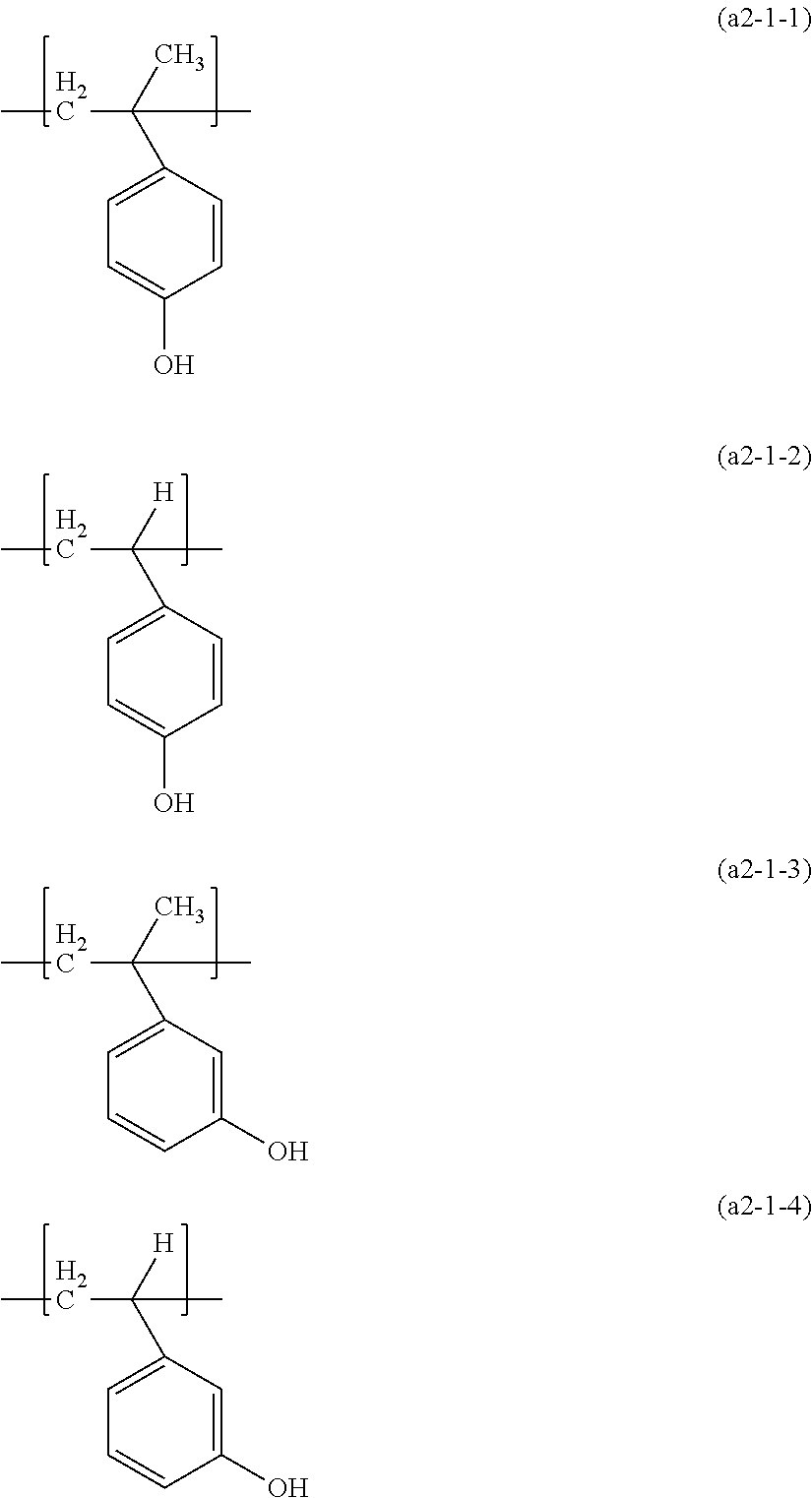
C00021
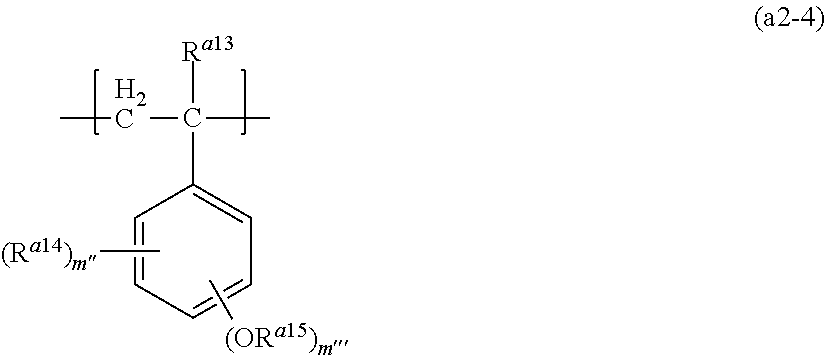
C00022

C00023

C00024

C00025

C00026

C00027

C00028
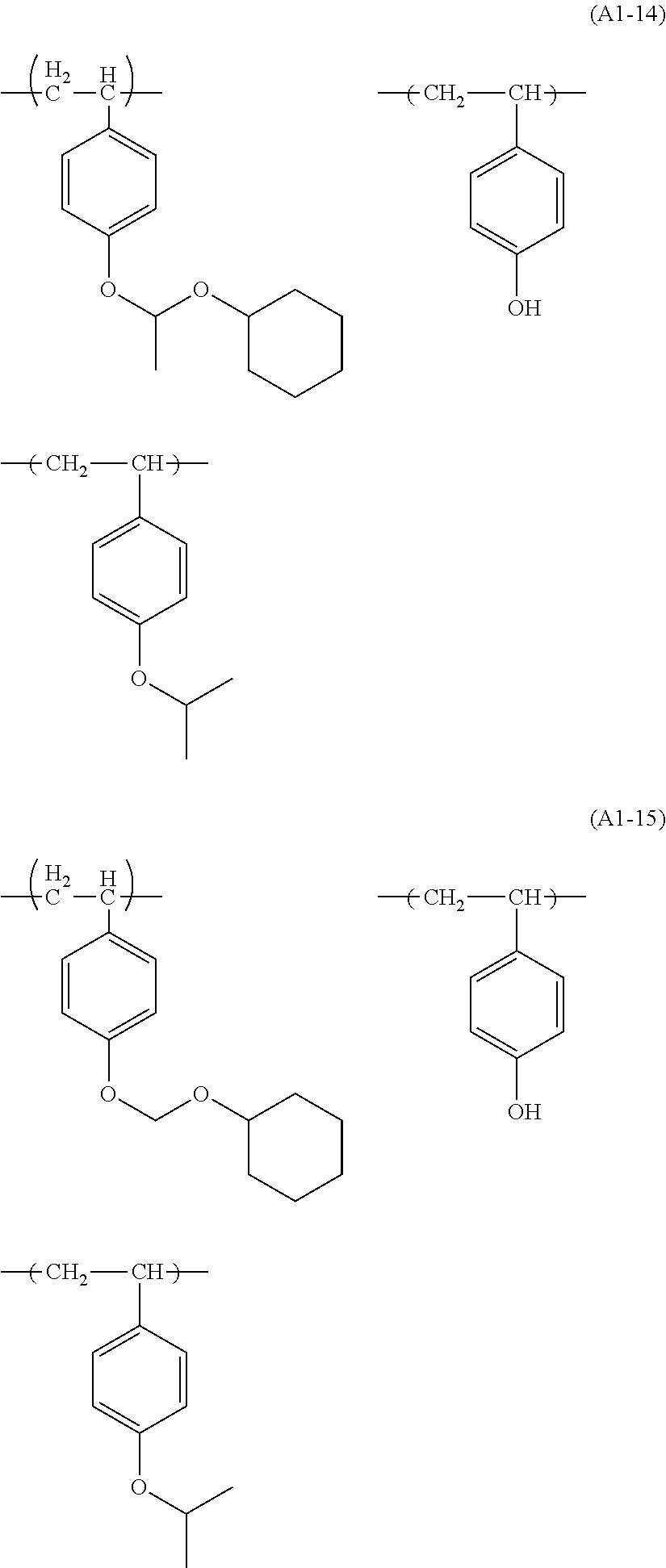
C00029
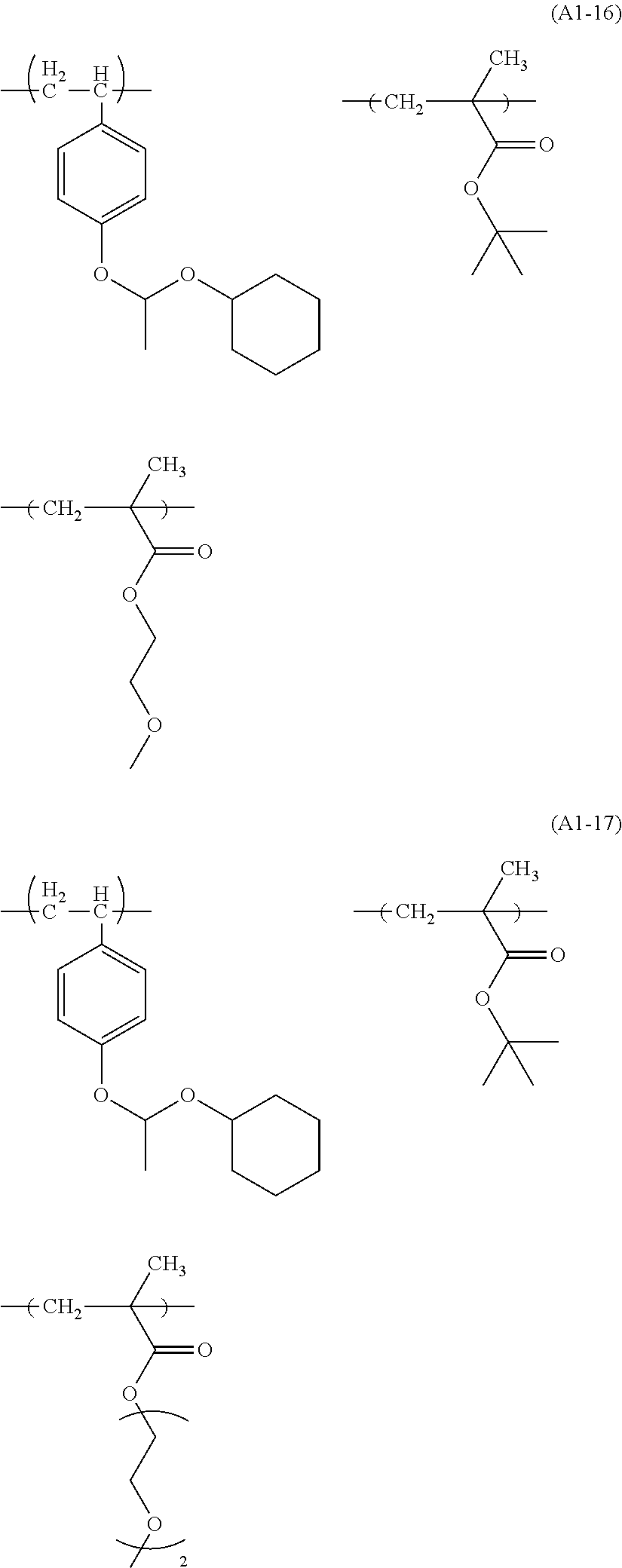
C00030

C00031

C00032

C00033

C00034

C00035
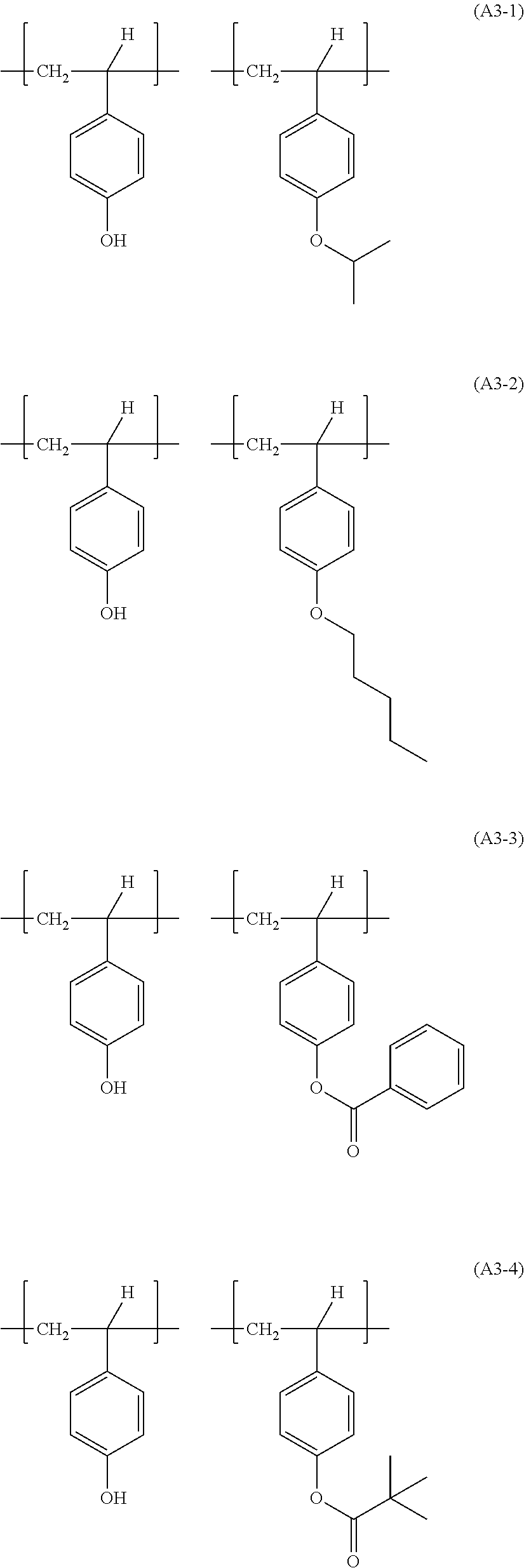
C00036

C00037

C00038

C00039
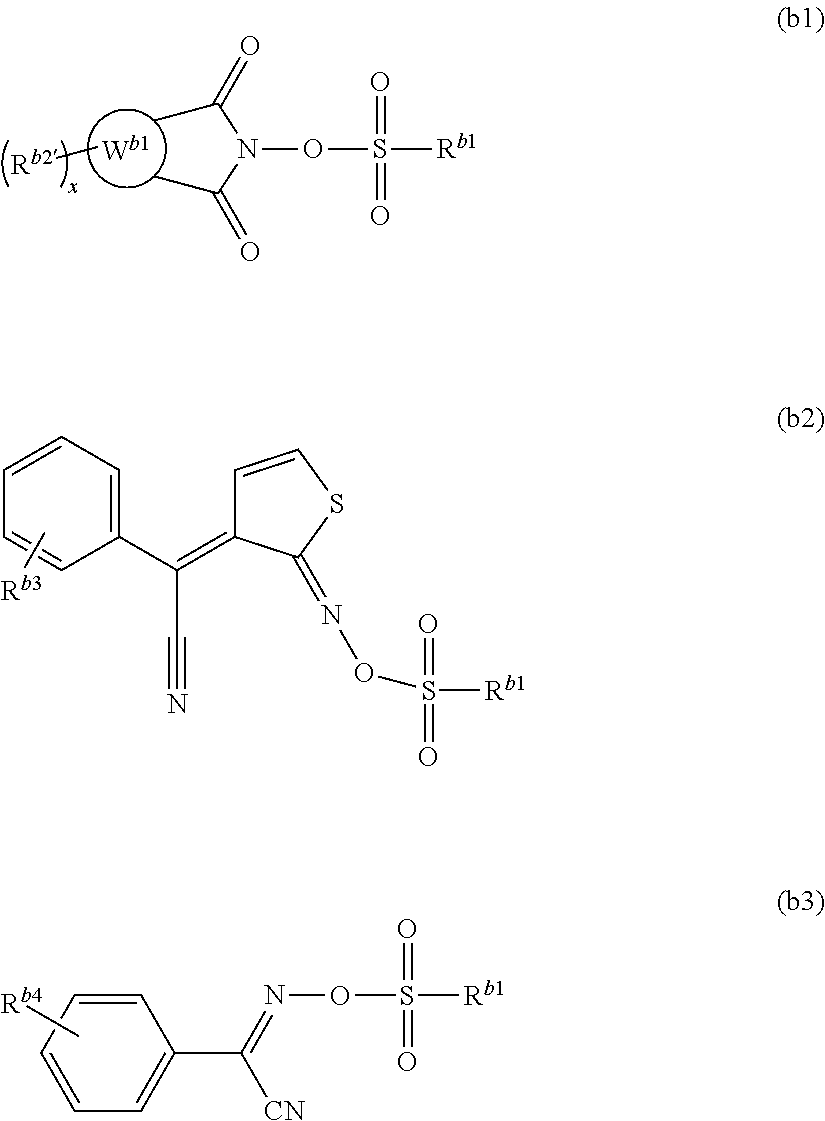
C00040
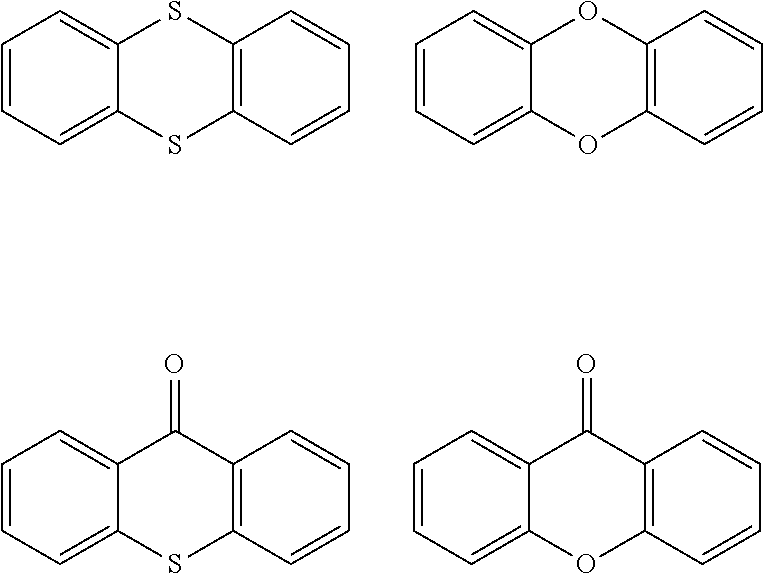
C00041

C00042

C00043

C00044

C00045
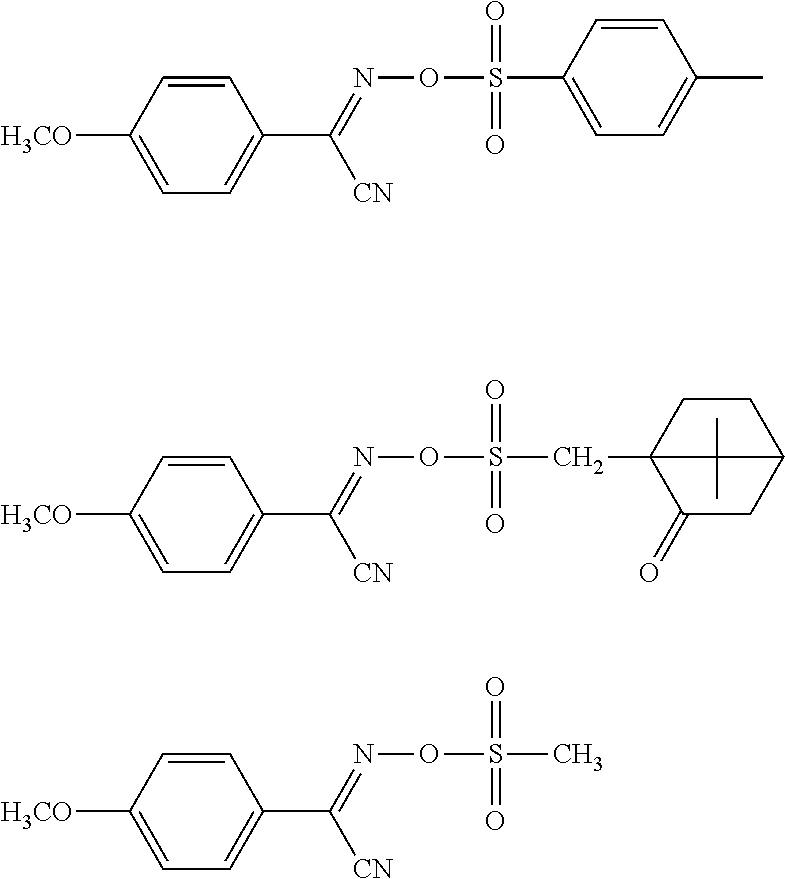
C00046
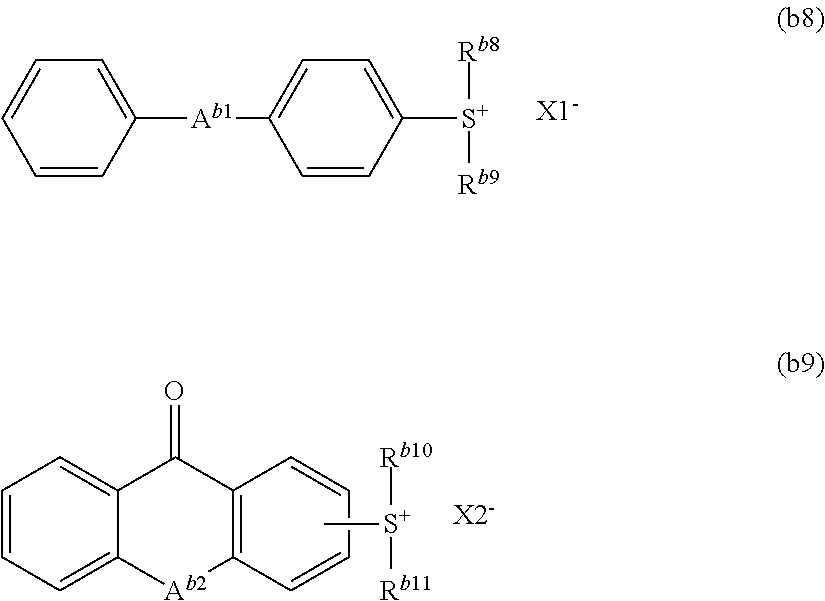
C00047

C00048

C00049

C00050

C00051

C00052

C00053

C00054

C00055
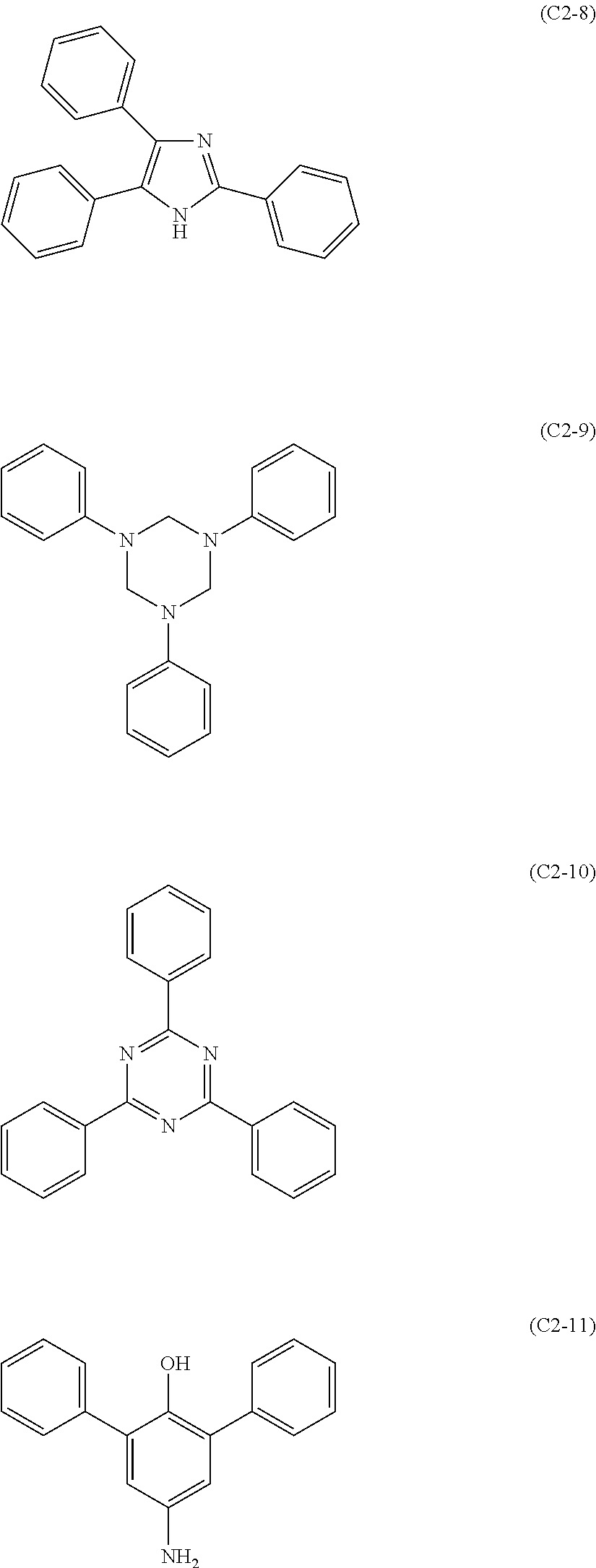
C00056

C00057

C00058
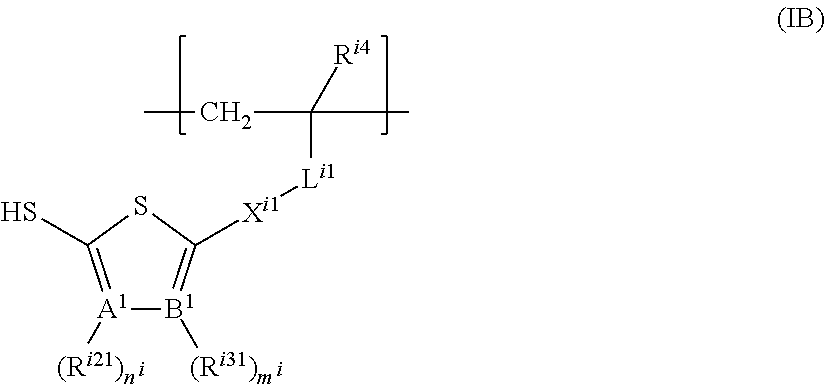
C00059

C00060

C00061

C00062

C00063

C00064

C00065

C00066
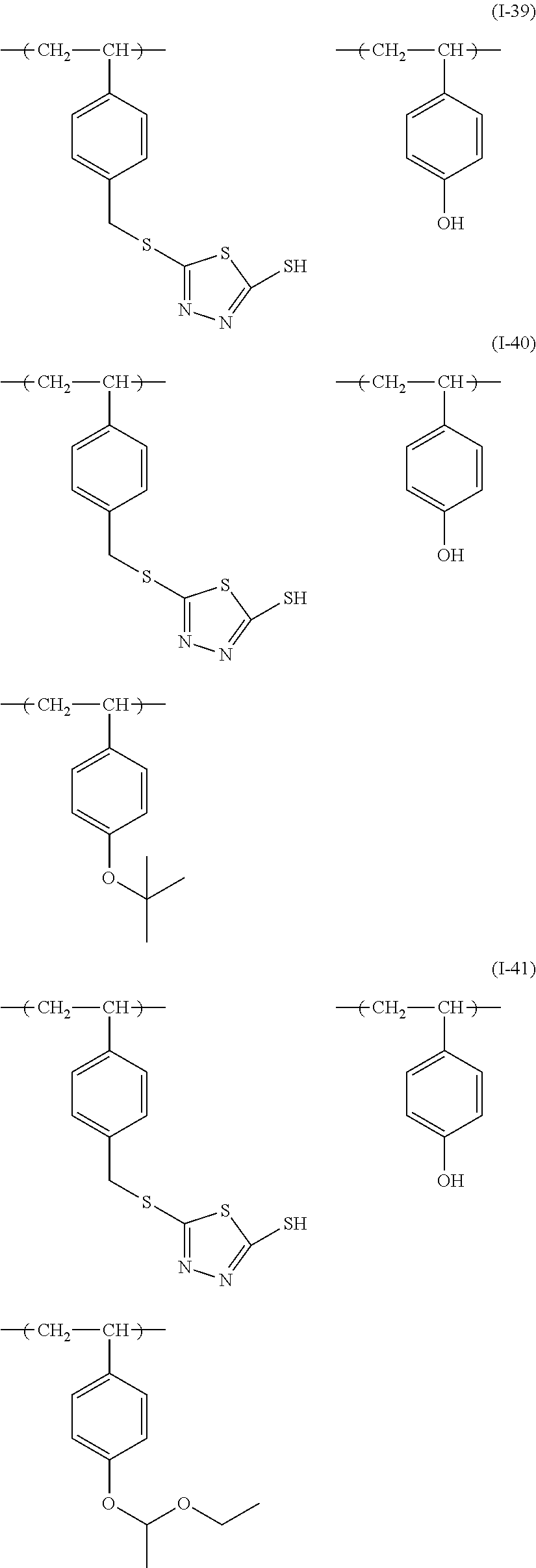
C00067

C00068

C00069

C00070

C00071

C00072

C00073

C00074
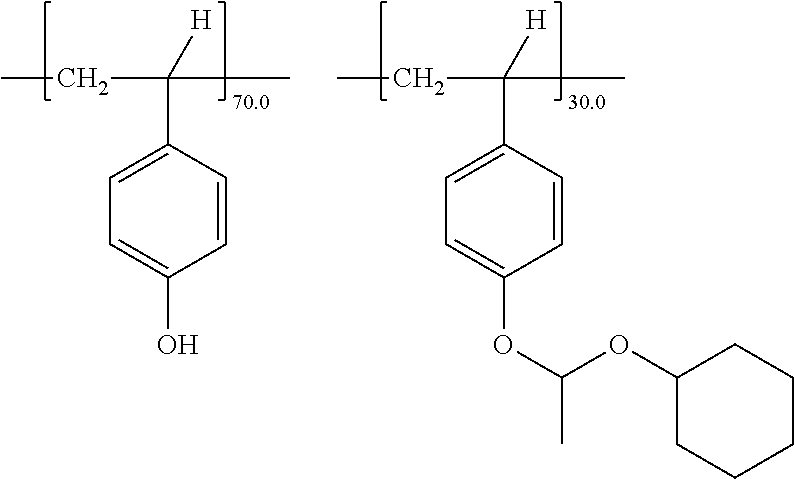
C00075

C00076

C00077

C00078

C00079

C00080
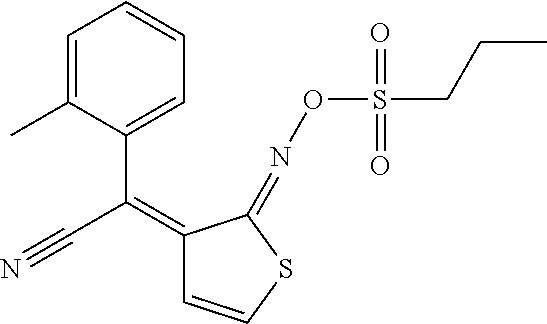
C00081

C00082

C00083

C00084

C00085

D00001

XML
uspto.report is an independent third-party trademark research tool that is not affiliated, endorsed, or sponsored by the United States Patent and Trademark Office (USPTO) or any other governmental organization. The information provided by uspto.report is based on publicly available data at the time of writing and is intended for informational purposes only.
While we strive to provide accurate and up-to-date information, we do not guarantee the accuracy, completeness, reliability, or suitability of the information displayed on this site. The use of this site is at your own risk. Any reliance you place on such information is therefore strictly at your own risk.
All official trademark data, including owner information, should be verified by visiting the official USPTO website at www.uspto.gov. This site is not intended to replace professional legal advice and should not be used as a substitute for consulting with a legal professional who is knowledgeable about trademark law.